Welcome to the world of birds in the Western Cape! This region of South Africa is home to a vast array of bird species with a wide variety of habitats, from the coastal wetlands of the West Coast to the dry plains of the Karoo and the rugged mountains of the Cape Winelands.
The Western Cape is a bird watcher’s paradise, with over 500 different species of birds to be found. From the gaudy and showy Cape Sugarbird to the rare and elusive Cape Rockjumper, the region offers something for everyone.
In this guide, we’ll explore some of the most remarkable bird species in the Western Cape, providing tips on where to look and how to identify them. So come along and join us in discovering this beautiful region’s avian inhabitants.
1. Cape Bulbul
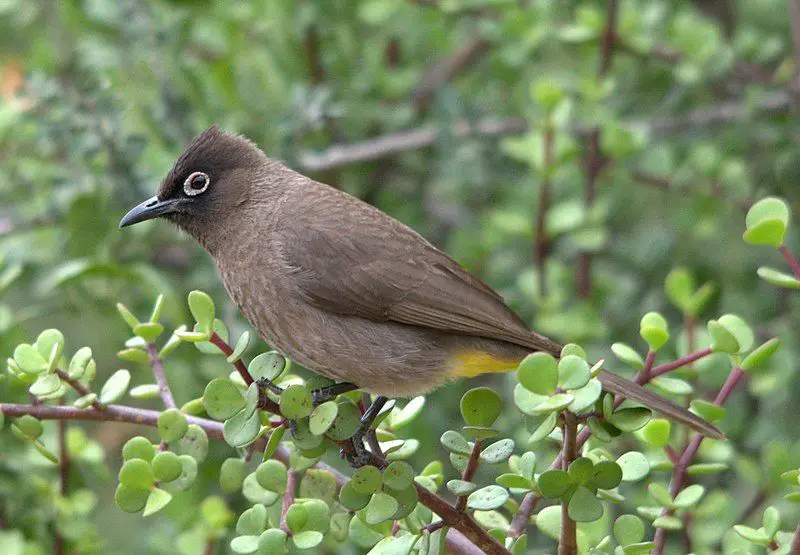
The Cape Bulbul is a species of passerine bird, belonging to the Bulbul family. It is a native bird, found only in South Africa, living and breeding in a variety of habitats such as coastal bush, open forests, gardens, and fynbos.
These habitats provide the bird with the food and shelter it needs to survive. The Cape Bulbul is a resident breeder, meaning it remains in its habitat throughout the year. It nests mainly in the southern spring, from September to November.
During this time, the birds build a nest and lay eggs. The chicks are then raised by the parents until they are ready to leave the nest and start their own lives.
The Cape Bulbul plays an important role in its environment, providing pest control by eating insects, as well as pollinating plants. It is an important part of the local ecosystem, and its numbers should be closely monitored to ensure its population remains healthy.
| Kingdom | Animalia |
| Phylum | Chordata |
| Class | Aves |
| Order | Passeriformes |
| Family | Pycnonotidae |
| Genus | Pycnonotus |
| Species | P. capensis |
2. Cape Sugarbird
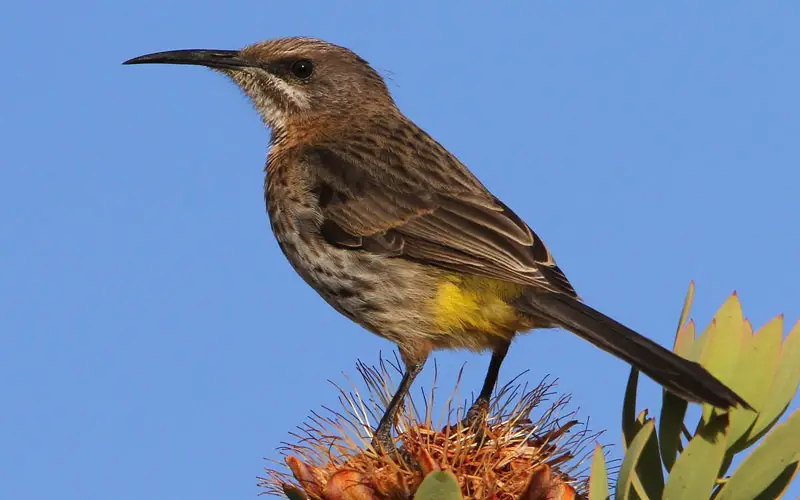
Source: ebird.org
The Cape sugarbird is a species of bird found only in South Africa. It is one of eight species that are endemic to the Fynbos biome, a region located in the Western and Eastern Cape provinces.
The Fynbos biome is characterized by a unique type of vegetation, which includes shrubs, grasses, and a diversity of flowering plants.
It is an important habitat for a number of species, including the Cape sugarbird. The Cape sugarbird has a distinctive appearance, with its long, curved beak and brownish-black feathers.
It feeds on nectar, pollen, and insects, and is especially attracted to proteas, an iconic genus of flowering plants that are found throughout the Fynbos biome.
It is usually found alone or in pairs, and nests in the forks of trees or shrubs. The Cape sugarbird is considered to be a vulnerable species due to habitat destruction, climate change, and other environmental threats.
It is also affected by the practice of harvesting proteas for commercial use, which has caused a decline in the number of suitable nesting sites.
To help protect the species, the South African government has established a number of protected areas within the Fynbos biome, and conservation efforts are ongoing.
| Kingdom | Animalia |
| Phylum | Chordata |
| Class | Aves |
| Order | Passeriformes |
| Family | Promeropidae |
| Genus | Promerops |
| Species | P. cafer |
3. Cape Cormorant
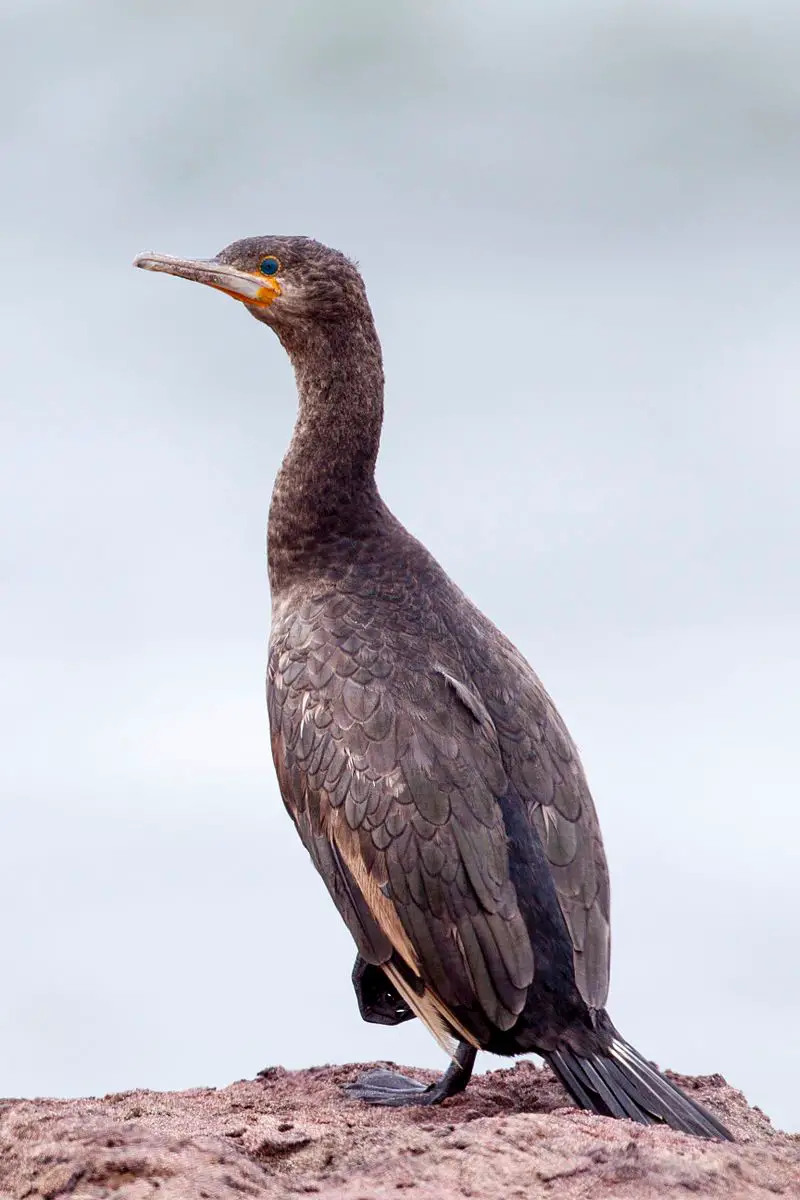
The Cape Cormorant is a bird species that is native to the southwestern coasts of the African continent. It breeds in the coastal region from Namibia to the southern Western Cape region of South Africa.
During the non-breeding season, it can be found as far north as the mouth of the Congo River, and it has been spotted traveling up the eastern coast of South Africa all the way to Mozambique.
This species of bird is a great example of adaptation and resilience, as it is able to move from one habitat to another in search of food and safety. In addition, its ability to survive in both cold and warm climates makes it a valuable species to the African continent.
| Kingdom | Animalia |
| Phylum | Chordata |
| Class | Aves |
| Order | Suliformes |
| Family | Phalacrocoracidae |
| Genus | Phalacrocorax |
| Species | P. capensis |
4. Hartlaub’s Gull
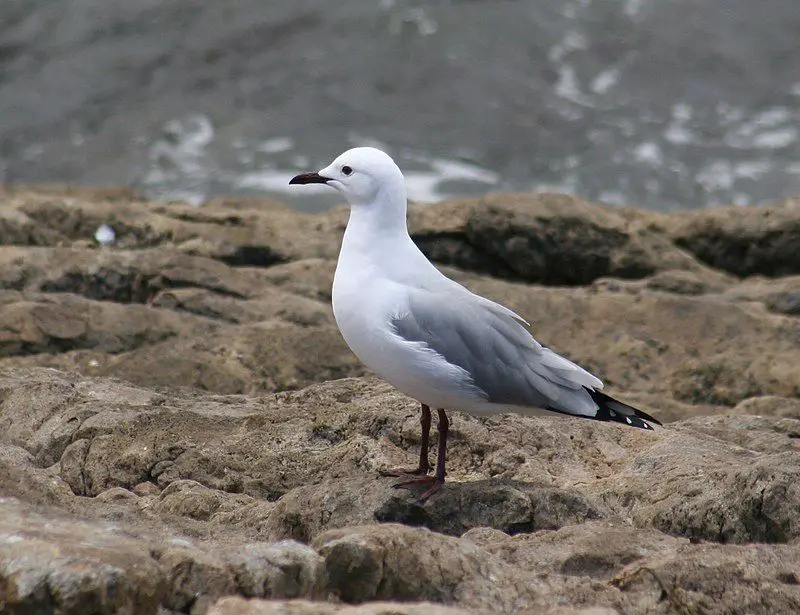
Hartlaub’s gull, also known as the king gull, is a small species of gull that was previously classified as a subspecies of the silver gull. It belongs to the genus Chroicocephalus, which is a genus of gulls that includes many other species.
The classification of Hartlaub’s gull has been debated for a long time, and it has been placed in different genera throughout its history. For example, it has been classified as a species of the genus Larus in the past.
However, it is now considered to be part of the genus Chroicocephalus, which is a group of seabirds that includes many other species of gulls. Hartlaub’s gull is a small gull, but its size is not the only thing that sets it apart from other species.
It has a unique plumage pattern, with a black hood, white head, and grayish-brown wings. It also has a distinct call, which is a loud “kree” sound. The species is found in a variety of habitats, including coastal areas, estuaries, and lakes.
It is an omnivore, and its diet consists of a variety of food items, including fish, mollusks, worms, and insects. Hartlaub’s gull is not a common species, and it is listed as near threatened by the IUCN Red List.
Its population is thought to be declining due to a variety of human-induced factors, including habitat destruction, pollution, and overfishing. Conservation efforts are needed to help protect this species and ensure its future survival.
| Kingdom | Animalia |
| Phylum | Chordata |
| Class | Aves |
| Order | Charadriiformes |
| Family | Laridae |
| Genus | Chroicocephalus |
| Species | C. hartlaubii |
5. Cape Vulture

The Cape vulture is a species of Old World vulture found in southern Africa. It is known by multiple names, including the Cape griffon and Kolbe’s vulture.
This species of vulture is endemic to the region, meaning it is native to this area and can be found nowhere else in the world. Its range includes South Africa, Lesotho, Botswana, and parts of northern Namibia. The Cape vulture nests on cliffs and typically lays one egg per year.
It is a relatively large bird, with adults reaching lengths of around three feet and wingspans of up to six feet. It is an important species in the region, as it helps to keep the local ecosystem in balance by scavenging for remains of dead animals.
It is also an important indicator species, as its presence can be taken as a sign of a healthy environment. As such, it is important to conserve this species and its habitats.
| Kingdom | Animalia |
| Phylum | Chordata |
| Class | Aves |
| Order | Accipitriformes |
| Family | Accipitridae |
| Genus | Gyps |
| Species | G. coprotheres |
6. Blue Crane
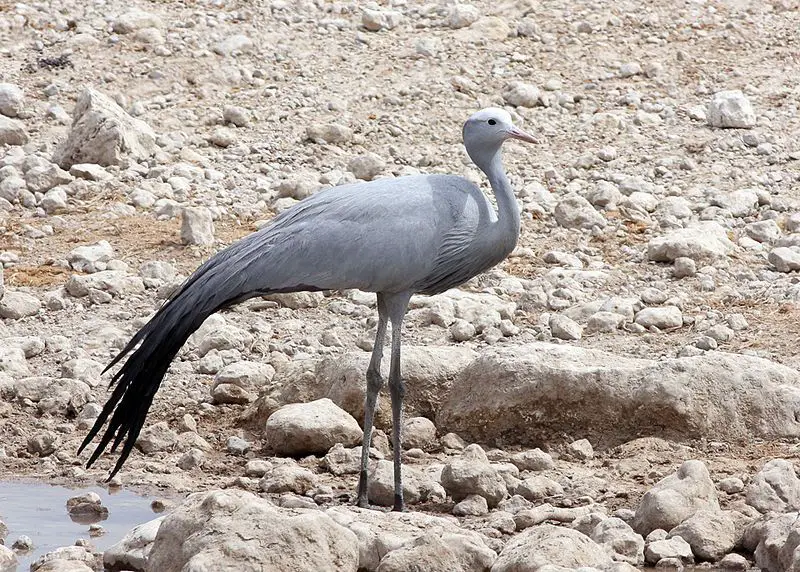
The blue crane is a widely recognized species of bird found across the African continent, particularly in South Africa. It is a large bird with a wingspan of up to 2.2 meters and a distinct blue-gray color.
It is also known as the Stanley crane or the paradise crane and is the national bird of South Africa. The species is listed as Vulnerable by the International Union for the Conservation of Nature and Natural Resources (IUCN).
This rating indicates that the species is at risk of extinction in the wild due to a variety of threats, including habitat loss and degradation, overgrazing, hunting, and climate change.
Conservation efforts, such as habitat protection and reintroduction programs, are being implemented to help protect and conserve the species. Additionally, education programs are being developed to increase awareness of the species’ plight and the need for its conservation.
| Kingdom | Animalia |
| Phylum | Chordata |
| Class | Aves |
| Order | Gruiformes |
| Family | Gruidae |
| Genus | Grus |
| Species | G. paradisea |
7. Promeropidae
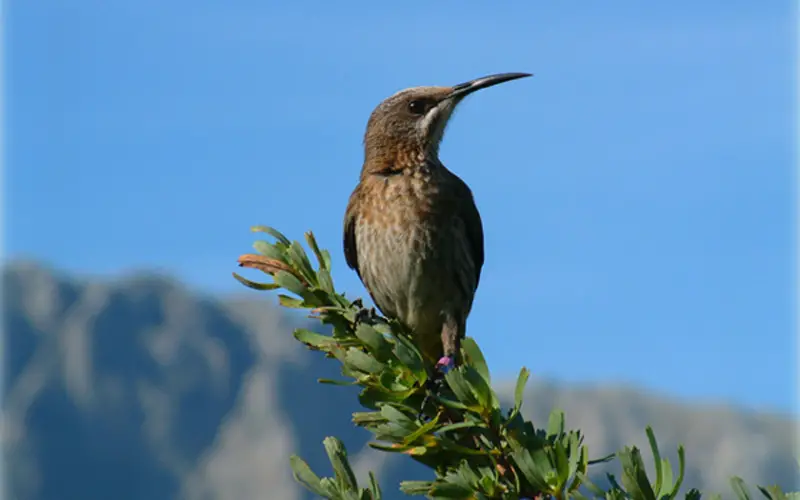
Source: wikipedia.org
The sugarbirds are a unique group of birds that are only found in the southern regions of Africa. They belong to the genus Promerops and the family Promeropidae. This makes them part of the passerine bird family, meaning they are perching birds that feed on insects and fruit.
These birds are small in size, measuring around 12 to 18 centimeters in length. They have distinctive black and white plumage, with a yellow or orange patch on their throats.
Sugarbirds are known for their sweet songs, which they use to attract mates and defend their territories. They also have a unique way of feeding, by extracting nectar from flowers with their long curved beaks.
They have a wide range of habitats, from high-altitude grasslands to lowland forests, and are able to adapt to a variety of environments.
| Kingdom | Animalia |
| Phylum | Chordata |
| Class | Aves |
| Order | Passeriformes |
| Family | Promeropidae |
| Genus | Promerops |
8. Lemon Dove
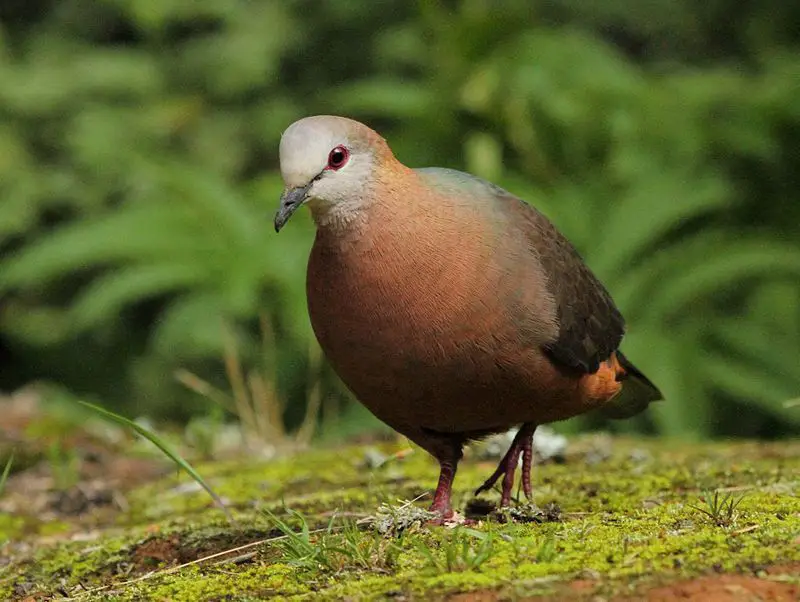
The lemon dove is a bird species belonging to the Columbidae family and is found mainly in the forests of sub-Saharan Africa. It is also known as the cinnamon dove, as it has a distinctive cinnamon-brown breast, set against a generally brownish-grey plumage.
Some experts consider the São Tomé lemon dove a separate subspecies. The bird has a gentle and peaceful demeanor, making it a popular species among bird watchers. It is usually found in pairs or small groups, and can often be heard singing its sweet, melodic song.
Its diet consists of small fruits, seeds, and insects. The lemon dove is also an important pollinator for local vegetation, contributing to the health of the ecosystems in which it lives.
| Kingdom | Animalia |
| Phylum | Chordata |
| Class | Aves |
| Order | Columbiformes |
| Family | Columbidae |
| Genus | Columba |
| Species | C. larvata |
9. Cape Weaver
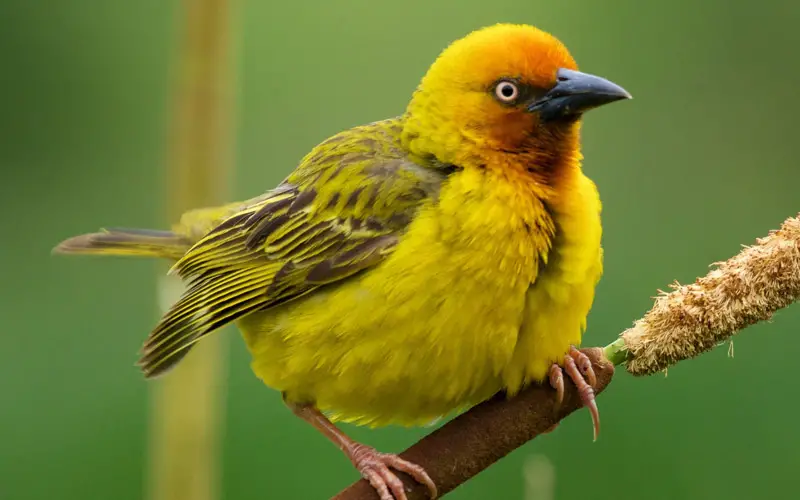
Source: ebird.org
The Cape weaver is a species of bird belonging to the weaver family, Ploceidae. It is found in a wide range of habitats across southern Africa, including fynbos, bushveld, and grassland. It is a small, plump bird with a bright yellow head and chest and a white belly.
The wings and tail are brown, while the back is greyish-brown. It has a black bill and legs. Cape weavers are known for their intricate nest-building abilities.
They construct a large, woven nest out of grass and other materials which is suspended from the branches of a tree or bush. The male takes the lead in gathering materials and building the nest, and the female will help to weave it together.
The nest is an important part of their breeding cycle, as it serves as a place for them to lay eggs and raise their young. Cape weavers feed mainly on insects, though they will also take some seeds and fruit.
They are usually found in small flocks, and they are known to be quite vocal, with a range of different calls and songs. Overall, the Cape weaver is an important species in southern Africa, both ecologically and culturally.
It is an iconic bird that has been featured in many paintings, photographs, and even sculptures. Its vibrant colors and unique nest-building abilities make it a fascinating species to observe and admire.
| Kingdom | Animalia |
| Phylum | Chordata |
| Class | Aves |
| Order | Passeriformes |
| Family | Ploceidae |
| Genus | Ploceus |
| Species | P. capensis |
10. White-backed Mousebird
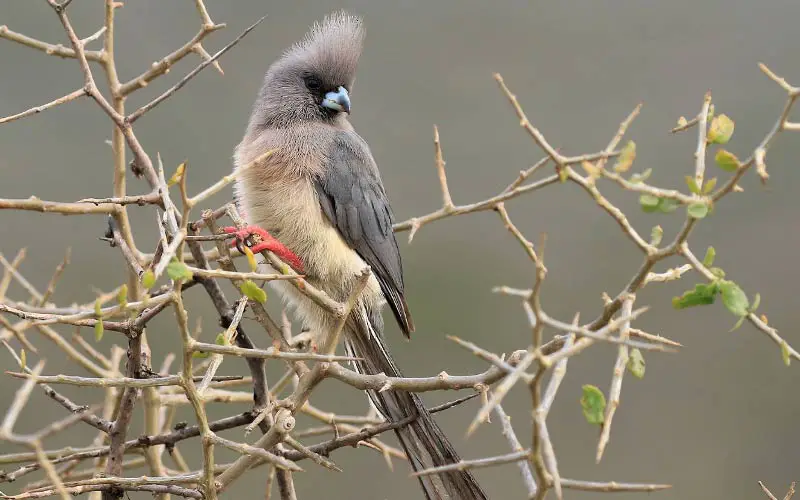
Source: ebird.org
The white-backed mousebird is a species of bird native to southern Africa. It is larger than other mousebirds and is found in western and central regions, stretching from Namibia and Botswana in the west to Central Transvaal and the Eastern Cape in the east.
This species prefers dry, scrubby habitats, such as thornveld, fynbos scrub, and semi-deserts. These are areas with low rainfall and sparse vegetation, which are home to many different species of animals.
The white-backed mousebird is well adapted to these types of environments, with its diet consisting of mainly insects and fruit. It can also be seen flitting among the trees and bushes of the scrub, searching for food.
The white-backed mousebird is a fairly common species in its range, and its population is generally stable. Though it is not considered threatened, it is still important to conserve its habitat in order to ensure that its population remains healthy.
This can be done by protecting and restoring large areas of scrubby land, allowing the mousebird to continue to thrive in its native environment.
| Kingdom | Animalia |
| Phylum | Chordata |
| Class | Aves |
| Order | Coliiformes |
| Family | Coliidae |
| Genus | Colius |
| Species | C. colius |
11. Spotted Eagle-owl
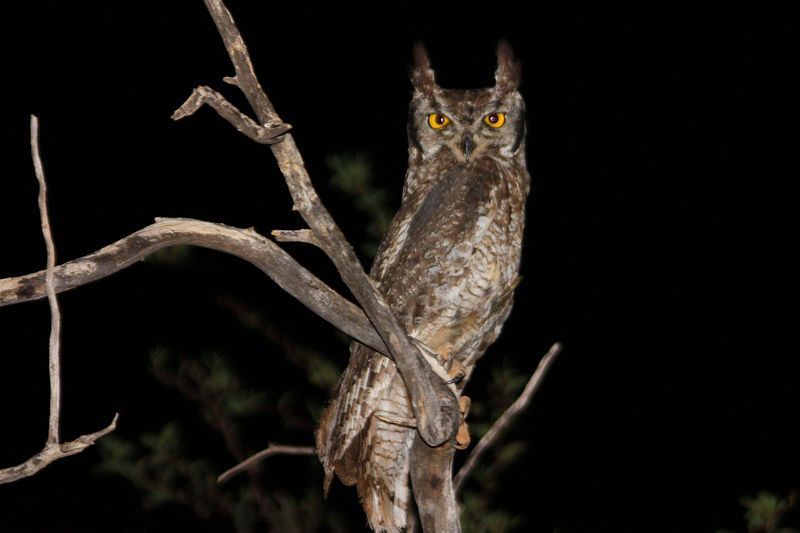
The spotted eagle-owl is a species of owl found in Africa. It is one of the smallest eagle owls, with an average length of 45 cm and a weight that ranges between 454 and 907 grams. This owl also has a large wingspan, measuring between 100 and 140 cm.
The spotted eagle-owl has several other names, including African spotted eagle-owl and African eagle-owl. The spotted eagle owl is usually found in grasslands, savannahs, and other open habitats.
Its diet consists mainly of small mammals such as rodents, small birds, reptiles, and insects. The spotted eagle-owl is a solitary species and is nocturnal, meaning it is most active at night.
It usually stays in the same territory and nests in hollow trees or cavities. The spotted eagle owl is considered near-threatened due to habitat loss and degradation. It is also hunted for its feathers, which are used in traditional ceremonies and cultural practices.
Conservation efforts are focused on protecting and restoring the owl’s natural habitats.
| Kingdom | Animalia |
| Phylum | Chordata |
| Class | Aves |
| Order | Strigiformes |
| Family | Strigidae |
| Genus | Bubo |
| Species | B. africanus |
12. Knysna Woodpecker
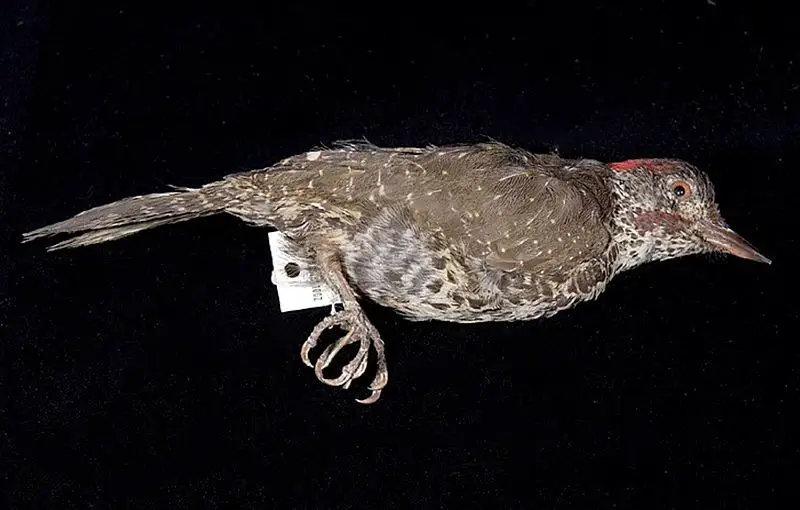
The Knysna woodpecker is a species of bird that belongs to the Picidae family. It is found exclusively in South Africa, and its natural habitats are subtropical or tropical moist lowland forests, moist savanna, and subtropical or tropical moist shrubland.
Unfortunately, this species is currently threatened by the destruction and fragmentation of its habitat. As development and land conversion continue, the forests and other natural habitats of the Knysna woodpecker are slowly disappearing.
As a result, the species is at risk of becoming extinct in the near future if conservation efforts are not made to protect its home range.
In order to protect the species, efforts must be made to preserve the forests, savanna, and shrubland of South Africa on which the Knysna woodpecker depends for survival.
| Kingdom | Animalia |
| Phylum | Chordata |
| Class | Aves |
| Order | Piciformes |
| Family | Picidae |
| Genus | Campethera |
| Species | C. notata |
13. Cape Spurfowl

The Cape spurfowl, also known as the Cape francolin, is a species of gamebird native to southern Africa. It is a member of the pheasant family Phasianidae and is the largest francolin of the region.
This bird can be found in the Western Cape province of South Africa and is also present in parts of southern Namibia. The Cape spurfowl is a medium-sized bird, with a rounded body and short legs. It has a brown back and wings, and a black and white spotted underside.
Males are typically larger than females, and they have a red face and throat. The Cape spurfowl has a loud, distinctive call that is used to attract mates and to communicate with other birds.
This species is endemic to southern Africa, and it prefers open grassland and scrubby areas. It feeds on seeds, insects, and other small invertebrates. Its primary predators are birds of prey, such as eagles and owls.
The Cape Spurfowl is a popular gamebird, and its meat is often used in traditional dishes. The Cape Spurfowl is listed as Least Concern on the IUCN Red List. Despite this, the species is still threatened by habitat loss and fragmentation due to agricultural activities.
Conservation measures are being implemented to ensure the survival of this species.
| Kingdom | Animalia |
| Phylum | Chordata |
| Class | Aves |
| Order | Galliformes |
| Family | Phasianidae |
| Genus | Pternistis |
| Species | P. capensis |
14. Southern Boubou
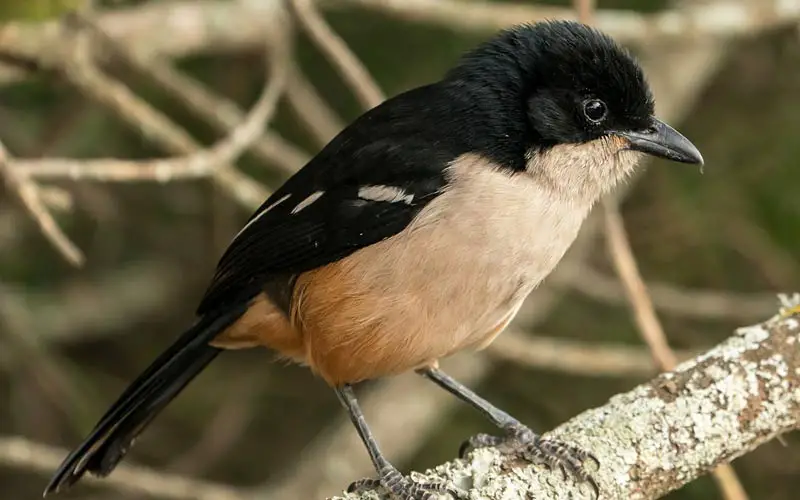
Source: ebird.org
The southern boubou is a type of bushshrike, which is a member of the passerine bird family. Passerine birds are also known as songbirds, and they are characterized by their perching and walking habits.
In the past, bushshrikes were often mistaken for true shrikes, which are members of the Laniidae family. However, modern research has revealed that bushshrikes are actually not closely related to true shrikes.
Despite their similar physical features, bushshrikes have a completely different genetic makeup and belong to a separate family.
| Kingdom | Animalia |
| Phylum | Chordata |
| Class | Aves |
| Order | Passeriformes |
| Family | Malaconotidae |
| Genus | Laniarius |
| Species | L. ferrugineus |
15. Black Harrier
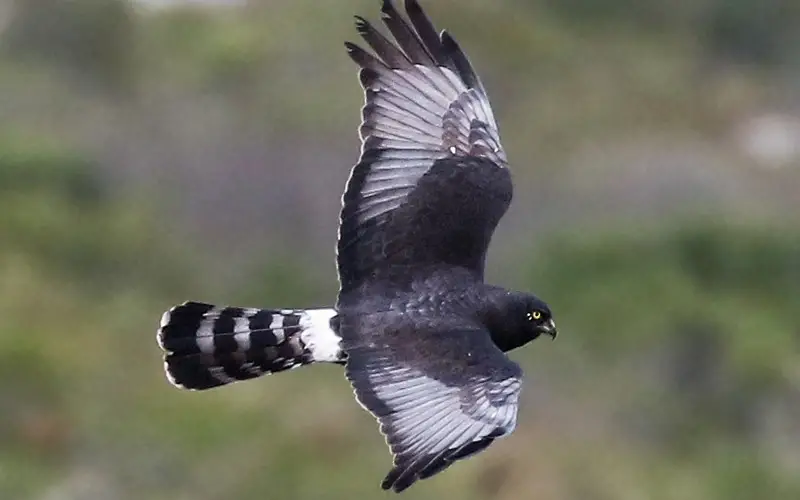
Source: ebird.org
The black harrier is a bird native to the African continent that is typically found in the regions of South Africa, Botswana, and Namibia.
It is considered to be a medium-sized bird with a wingspan that typically ranges from 105 to 115 centimeters and a body length of 44 to 50 centimeters. When perched, the black harrier appears to be entirely black in coloration.
However, when it is in flight, it reveals a white rump and white flight feathers that contrast with its otherwise dark body. This makes the bird easily identifiable in the sky and helps to distinguish it from other bird species in the area.
| Kingdom | Animalia |
| Phylum | Chordata |
| Class | Aves |
| Order | Accipitriformes |
| Family | Accipitridae |
| Genus | Circus |
| Species | C. maurus |
16. Malachite Kingfisher
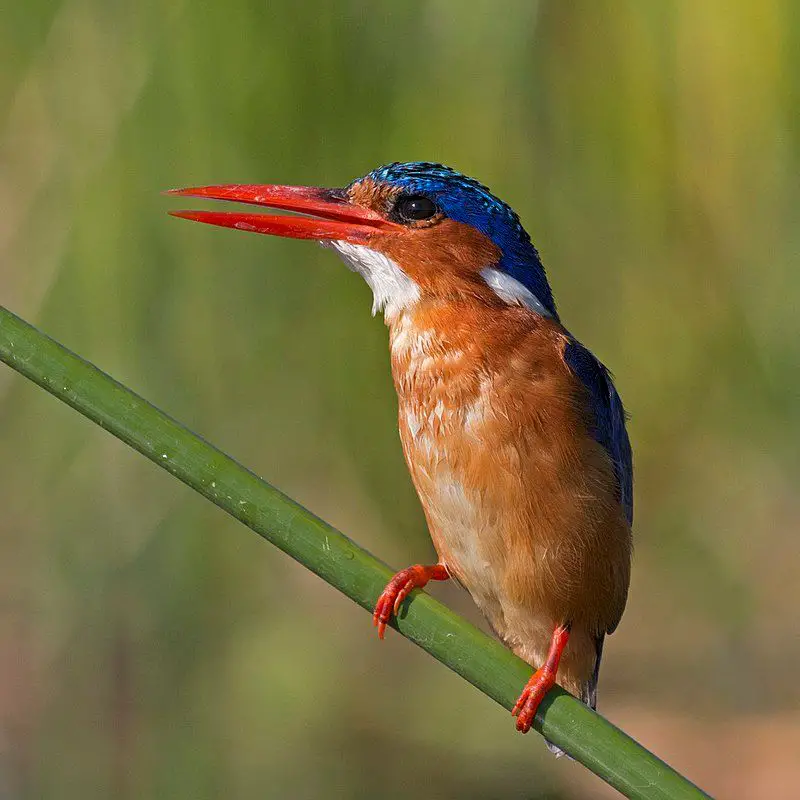
The Malachite Kingfisher is a species of river kingfisher, a type of bird that is typically found near bodies of water.
It is native to the African continent south of the Sahara desert, and it is generally seen as being a resident species in the area, meaning it does not migrate away from its habitat.
However, in certain cases, its movements may be affected by seasonal climate changes, which could cause the bird to relocate its nesting grounds to areas with more favorable conditions.
This species of kingfisher is known for its bright green plumage, which is why it is named the Malachite Kingfisher. The bird has a large bill that it uses to catch its prey, typically small fish and aquatic insects.
It is a popular sight for birdwatchers, as it is a colorful and distinctive species.
| Kingdom | Animalia |
| Phylum | Chordata |
| Class | Aves |
| Order | Coraciiformes |
| Family | Alcedinidae |
| Genus | Corythornis |
| Species | C. cristatus |
17. Southern Black Korhaan
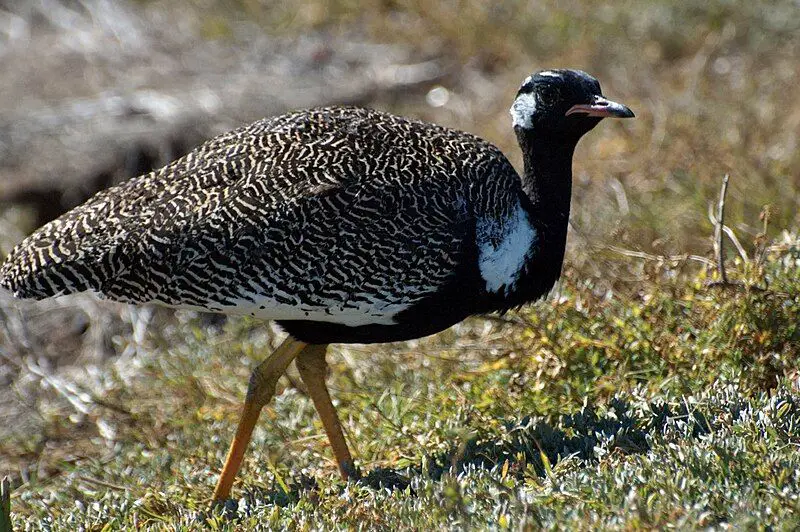
The southern black korhaan, also known as the black bustard, is a species of bird belonging to the bustard family, Otididae. This bird is native to the southwestern region of South Africa, ranging from Namaqualand in the north to Cape Town in the south and Makhanda in the east.
The black korhaan is a small bustard, with males weighing around 1.2 kg and females around 0.8 kg. It is a mostly grey-brown bird, with a white throat and light brown underparts. Its crown, chest, and nape are black, and its tail is tipped with a white stripe.
The black korhaan is a ground-dwelling bird, foraging for food such as grasshoppers, beetles, and other insects on the ground. It typically lives in open savannah and grassland areas, but may also inhabit rocky scrublands and cultivated areas.
The black korhaan is a non-migratory species, and it is listed as Least Concern by the IUCN.
| Kingdom | Animalia |
| Phylum | Chordata |
| Class | Aves |
| Order | Otidiformes |
| Family | Otididae |
| Genus | Afrotis |
| Species | A. afra |
18. Olive Woodpecker
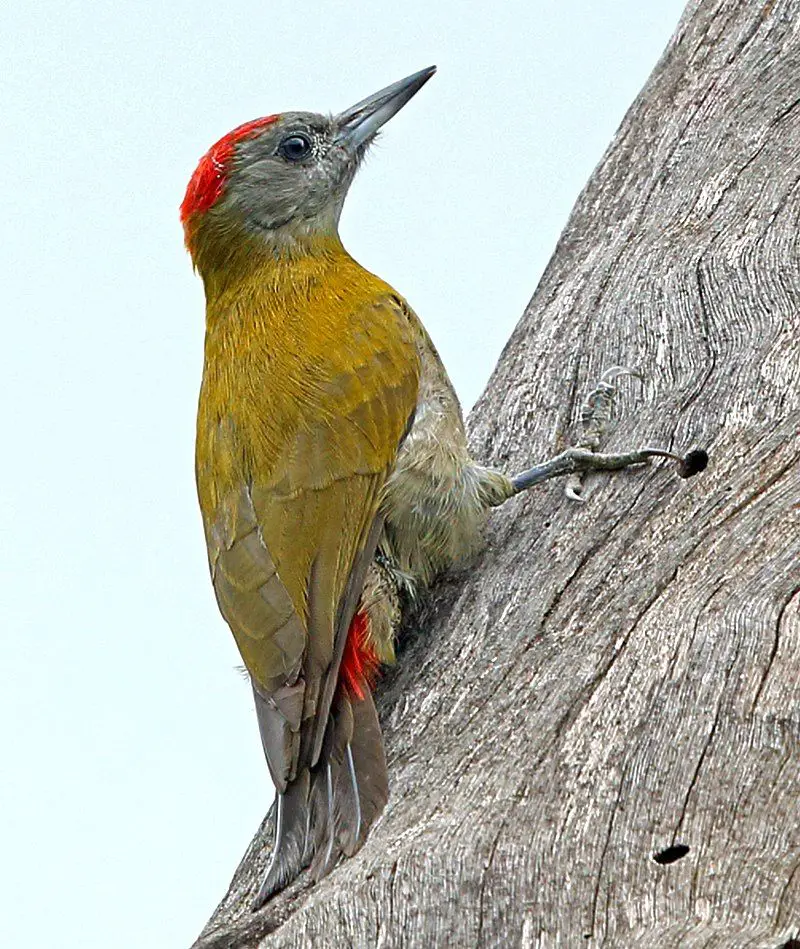
The olive woodpecker is a species of bird found in parts of Europe, Africa, and Asia. It is a medium-sized bird, measuring between 18 and 20 cm in length, with a wingspan of 33 to 38 cm.
The males have a characteristic black and white striped head and back, while the females have a brown head and back. The breast and belly are mostly white, with a yellowish hue on the sides.
The olive woodpecker is a member of the Picidae family, which includes other woodpecker species such as the great spotted woodpecker and the black woodpecker. The olive woodpecker is an arboreal species, which means it spends much of its time in trees.
It feeds mostly on insects, although it will also feed on fruit, nuts, and seeds. It has a loud voice and a distinctive call, which is often heard in wooded areas. The olive woodpecker is a cavity nester, meaning it will excavate a nesting hole in dead trees or decaying wood.
The hole is usually lined with wood chips and the female will lay three to four eggs. The eggs are white in color and the young will fledge after 20 to 24 days. The olive woodpecker is a common species and is not considered to be threatened.
However, as with many species, the numbers of olive woodpeckers are declining due to habitat loss and fragmentation. Conservation efforts are needed to ensure the survival of this species.
| Kingdom | Animalia |
| Phylum | Chordata |
| Class | Aves |
| Order | Piciformes |
| Family | Picidae |
| Genus | Dendropicos |
| Species | D. griseocephalus |
19. Scaly-feathered Weaver
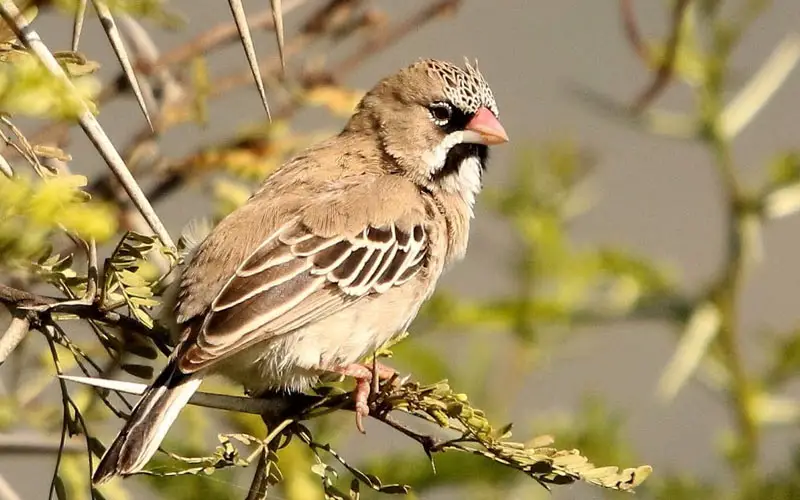
The scaly-feathered weaver is a species of bird belonging to the family Ploceidae. It is found in six countries of Southern Africa, namely Angola, Botswana, Namibia, South Africa, Zambia, and Zimbabwe.
It is also known as the scaly-feathered finch. The scaly-feathered weaver is a small bird, measuring around 7.5 to 8 inches in length. It has a rufous-brown crown, back, and wings, and a white throat. Its name comes from its scaly-looking feathers which are gray in color.
The males of this species have yellowish-green faces, whereas the females have brownish-gray faces. The scaly-feathered weaver is mainly found in grasslands and open woodlands. It is a gregarious bird, usually occurring in small flocks of up to a dozen birds.
It feeds mainly on small seeds, grains, and insects. They are very active birds, often seen foraging on the ground for food. The scaly-feathered weaver is a common and widespread species and is not considered to be threatened or endangered.
It is listed as a species of least concern by the International Union for Conservation of Nature and Natural Resources (IUCN).
| Kingdom | Animalia |
| Phylum | Chordata |
| Class | Aves |
| Order | Passeriformes |
| Family | Ploceidae |
| Genus | Sporopipes |
| Species | S. squamifrons |
20. Speckled Mousebird
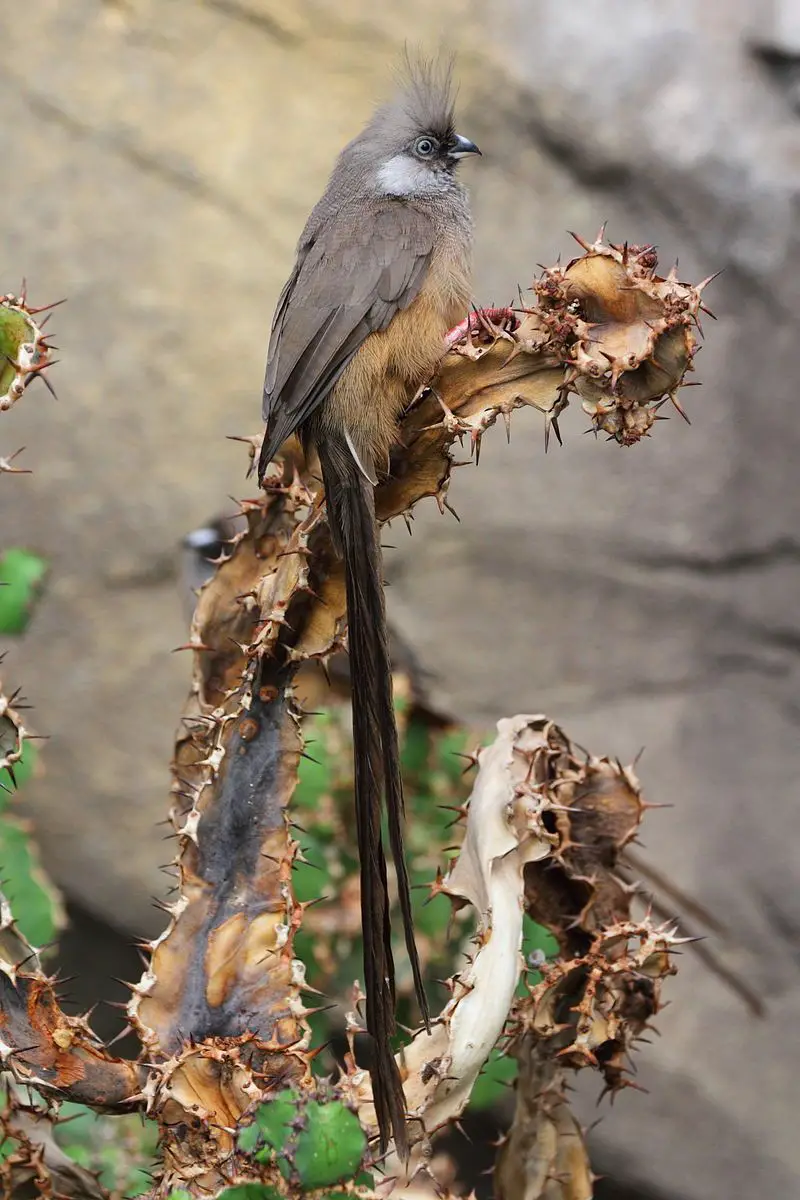
The speckled mousebird is a species of bird that is found throughout Central, Eastern and Southern Africa. It is the largest of the mousebird species and is also one of the most common. It has a distinctive speckled pattern along its feathers, giving it its name.
The speckled mousebird is also known for its unique behavior and ability to mimic the sounds of other animals. They are often seen in groups and can be found in a variety of habitats, from grasslands to forests.
They are omnivores and feed on a variety of insects, fruits, and seeds. They are known to build their nests in trees, and some species have even been found to nest in shrubs.
The speckled mousebird is an important part of the African ecosystem, as they help to keep insect populations in check and disperse seeds.
| Kingdom | Animalia |
| Phylum | Chordata |
| Class | Aves |
| Order | Coliiformes |
| Family | Coliidae |
| Genus | Colius |
| Species | C. striatus |
21. Cape Wagtail
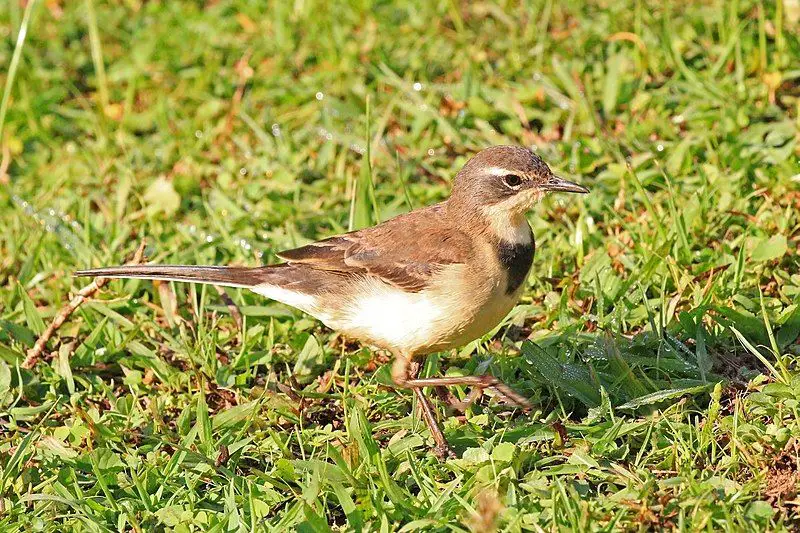
The Cape wagtail, also known as Wells’s wagtail, is a small insectivorous bird found in various habitats throughout southern Africa. It is a familiar sight in and near water, such as rivers, streams, and wetlands, as well as in lawns and gardens.
It is a mostly resident species, meaning that it typically stays in the same area year-round. However, it has been known to undertake limited altitudinal migration, meaning that it may move between different altitudes in response to seasonal changes such as temperature.
Additionally, outside of the breeding season, Cape wagtails may form large flocks with other members of their species. These flocks can be quite large, with up to several hundred birds in a single group.
They may travel together in search of food or find suitable breeding grounds. The Cape wagtail is an important part of the southern African ecosystems, and its presence indicates the presence of healthy, diverse habitats.
| Kingdom | Animalia |
| Phylum | Chordata |
| Class | Aves |
| Order | Passeriformes |
| Family | Motacillidae |
| Genus | Motacilla |
| Species | M. capensis |
22. Ludwig’s Bustard
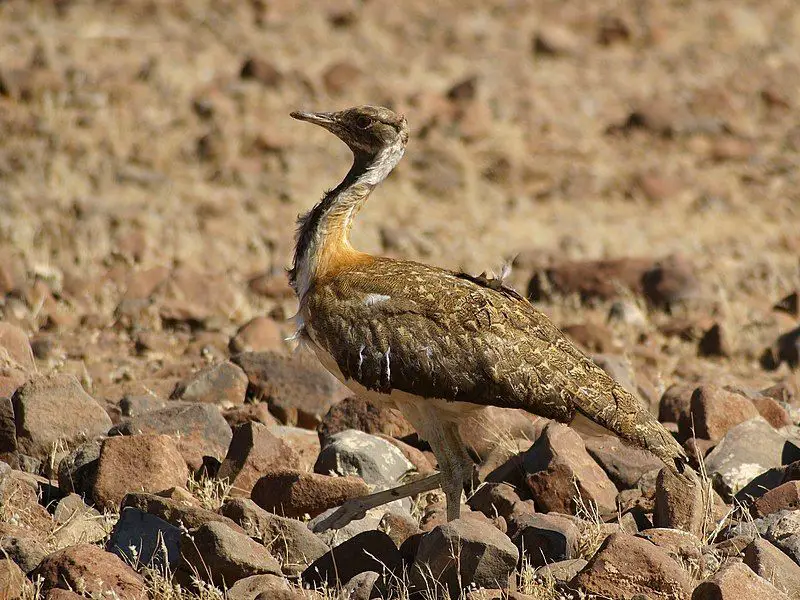
Ludwig’s bustard is a species of bird belonging to the bustard family. It is named after Baron von Ludwig, a renowned German naturalist, and it is native to the African continent. The bird has a medium-to-large size, with males typically being larger than females.
It has a distinctive head pattern, with a grey crown, black face, and white throat. The upper parts of its body are brown and the underparts are white. The wings are usually grey and white-barred. Ludwig’s bustard can be found in grasslands, semi-deserts, and open woodlands.
They feed on seeds, insects, and other small invertebrates. They are ground-dwelling birds and can often be seen walking or running on the ground in search of food. They are usually solitary birds, but can form small groups.
During the breeding season, males perform an elaborate courtship display, which includes fanning their wings and displaying their white throats. Ludwig’s bustard is an endangered species, due to hunting and the destruction of its natural habitat.
Conservation efforts are underway to protect the species and its habitat and to ensure its survival in the wild.
| Kingdom | Animalia |
| Phylum | Chordata |
| Class | Aves |
| Order | Otidiformes |
| Family | Otididae |
| Genus | Neotis |
| Species | N. ludwigii |
23. Red-necked Spurfowl
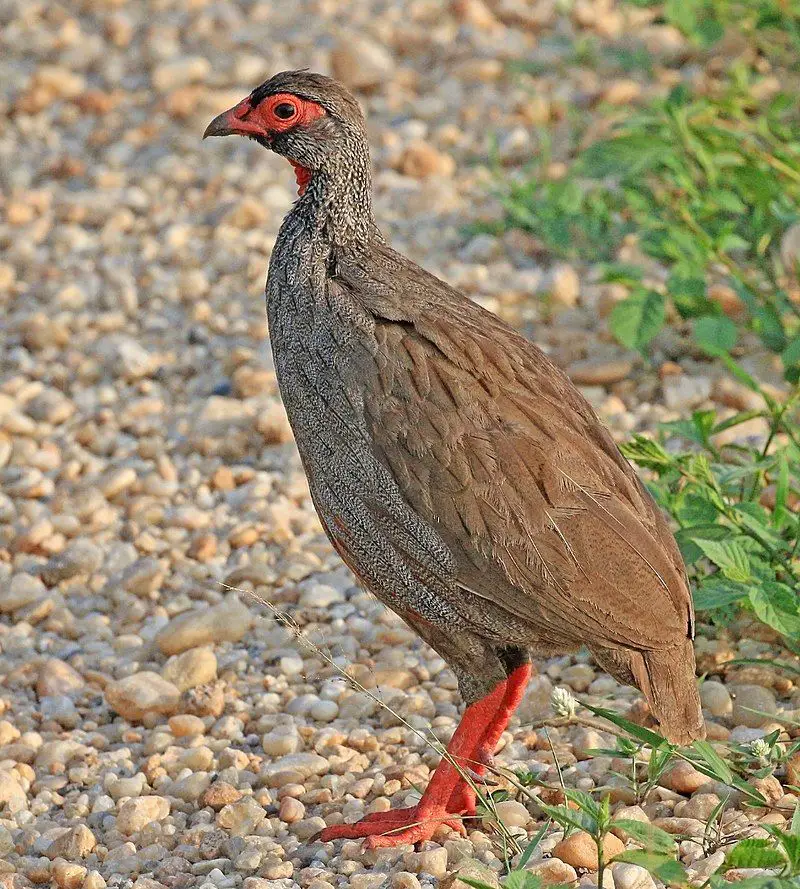
The red-necked spurfowl, also known as the red-necked francolin, is a type of game bird that is native to southern Africa. It is a member of the pheasant family Phasianidae and is a fairly common species in the region.
This bird is a ground dweller, living in open savannas and grasslands where it can find enough food to sustain itself. It is a small bird, typically around 25-30 cm in length, and has a distinctive red patch of feathers on its neck.
This patch of feathers is what gives the bird its name. The red-necked spurfowl tends to live in small flocks and is an omnivorous species that eats a variety of small invertebrates, fruits, seeds, and other plant material.
It is also considered a gamebird and is hunted by humans for sport.
The red-necked spurfowl is also prized for its meat, which is often used in traditional African cooking. Overall, the red-necked spurfowl is an important species of bird in southern Africa and has a long history within the region.
It is a popular gamebird that is hunted for sport, and its meat is widely used in traditional African cooking. It is also a beautiful bird with its distinctive red patch of feathers and is a common sight in the region.
| Kingdom | Animalia |
| Phylum | Chordata |
| Class | Aves |
| Order | Galliformes |
| Family | Phasianidae |
| Genus | Pternistis |
| Species | P. afer |
24. Kelp Gull
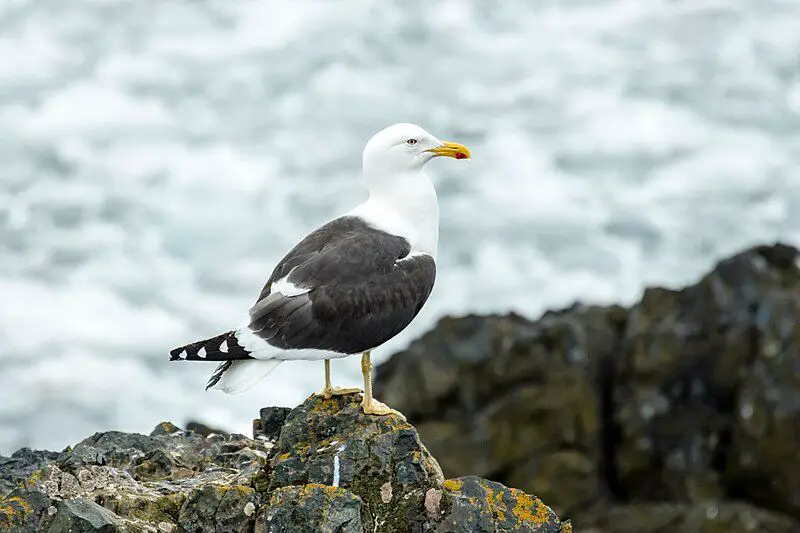
The kelp gull, also known as the Dominican gull, is a species of gull that can be found in many areas of the Southern Hemisphere. It breeds on coasts and islands in many parts of the region. The nominate subspecies, L. d.
Dominicans are found in areas such as South America, Australia, and New Zealand. Another subspecies, L. d. vetula, is found around Southern Africa. This species is well-adapted to its environment and has a wide range of habitats.
It is a relatively large bird, with a wingspan of up to 1.2 meters, and a length of up to 50 cm. It has a distinctive white head and neck, with grey wings, and a black band across its back.
Its diet consists mainly of fish and other marine life, and it can often be seen scavenging along the shoreline. The kelp gull is a fairly widespread species, and its population is thought to be stable.
| Kingdom | Animalia |
| Phylum | Chordata |
| Class | Aves |
| Order | Charadriiformes |
| Family | Laridae |
| Genus | Larus |
| Species | L. dominicanus |
25. White-fronted Plover
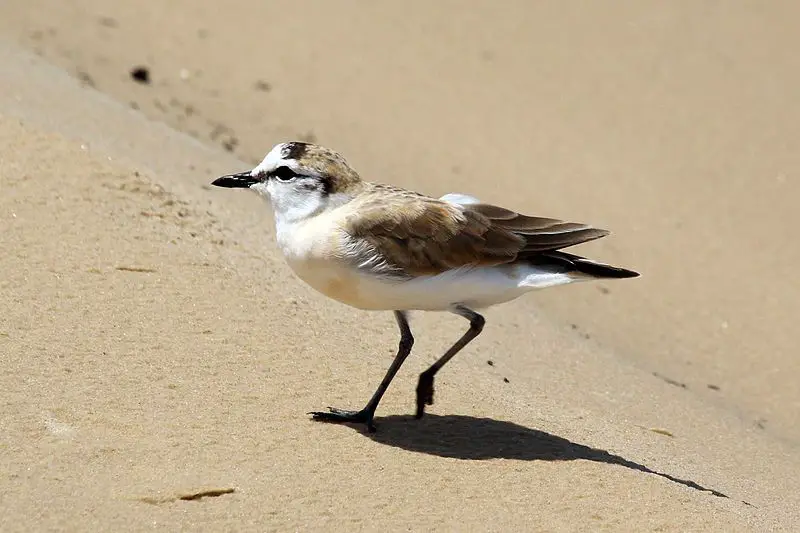
The white-fronted plover, also known as the white-fronted sand plover, is a species of shorebird that belongs to the family Charadriidae.
This bird species is found in many parts of sub-Saharan Africa and Madagascar, where it inhabits sandy beaches, dunes, mudflats, and the shores of rivers and lakes. The white-fronted plover is a small shorebird, typically having a length of 15-19 cm.
It has distinctive white markings on its forehead, which gives it its name.
This species of bird is usually found foraging on the shoreline for food, such as insects, crustaceans, and small mollusks. The white-fronted plover is a ground nester, which means that it builds its nest in shallow scrapes in the ground.
The female typically lays clutches of one to three eggs.
After hatching, the chicks are tended to by both parents until they are ready to fledge. The white-fronted plover is an important species for coastal ecosystems, as it helps to control populations of small insects and other invertebrates.
Unfortunately, this species is threatened by habitat destruction due to human activity, particularly the destruction of beaches and dunes due to coastal development. It is also threatened by predation from cats, dogs, and other predators.
Conservation efforts must be taken to protect this species and ensure that its populations remain healthy.
| Kingdom | Animalia |
| Phylum | Chordata |
| Class | Aves |
| Order | Charadriiformes |
| Family | Charadriidae |
| Genus | Charadrius |
| Species | C. marginatus |
26. Olive Thrush
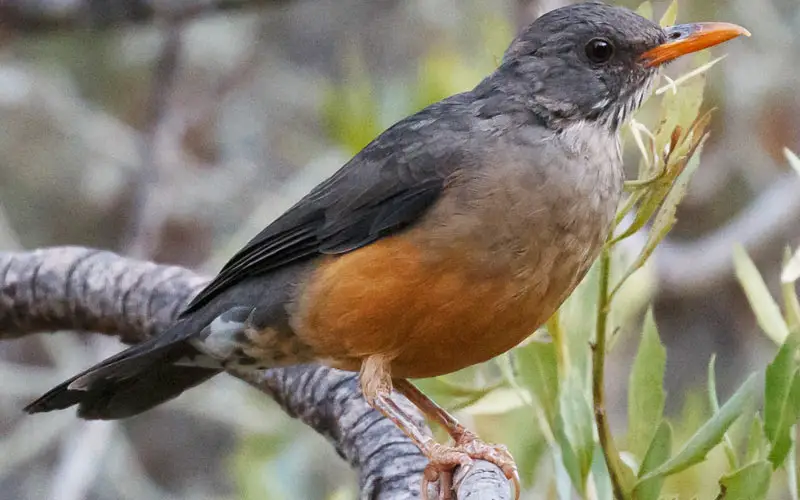
Source: ebird.org
The olive thrush is a common bird in the thrush family that can be found in the African highlands. It is found in countries like Malawi, Mozambique, and South Africa, particularly in forests and woodlands.
Additionally, it has adapted to parks and gardens in suburban areas, showing its ability to adjust to man-made environments. The olive thrush has a wide range of habitat preferences, allowing it to be found in areas ranging from the north of Malawi and Mozambique to the south of the Cape of Good Hope.
It has a preference for dense forests and woodlands, but it is able to survive in open habitats like parks or gardens in cities.
This is an example of how the bird has adapted to human-altered environments. The olive thrush is an important species in its range, as it plays a crucial role in the ecosystem.
It primarily feeds on insects, small fruits, and seeds, providing a valuable contribution to the food chain. Additionally, its constant presence in the African highlands also serves as an important indicator of the health of the region’s ecosystems.
| Kingdom | Animalia |
| Phylum | Chordata |
| Class | Aves |
| Order | Passeriformes |
| Family | Turdidae |
| Genus | Turdus |
| Species | T. olivaceus |
27. Red-winged Starling
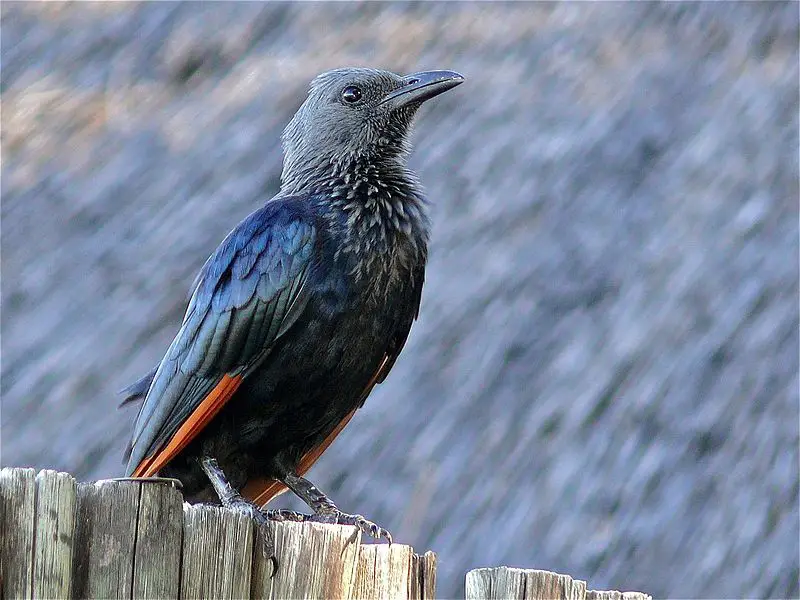
The red-winged starling is a species of bird belonging to the Sturnidae family, native to Eastern Africa. Its range spans from Ethiopia to the Cape in South Africa. It is an omnivorous species, meaning it feeds on both plants and animals.
It can be found in a variety of habitats but tends to prefer cliffs and mountainous areas for nesting. The species has adapted well to urban environments due to its similarity to its original habitat, allowing it to flock in urban areas such as towns and cities.
| Kingdom | Animalia |
| Phylum | Chordata |
| Class | Aves |
| Order | Passeriformes |
| Family | Sturnidae |
| Genus | Onychognathus |
| Species | O. morio |
28. Southern Double-collared Sunbird
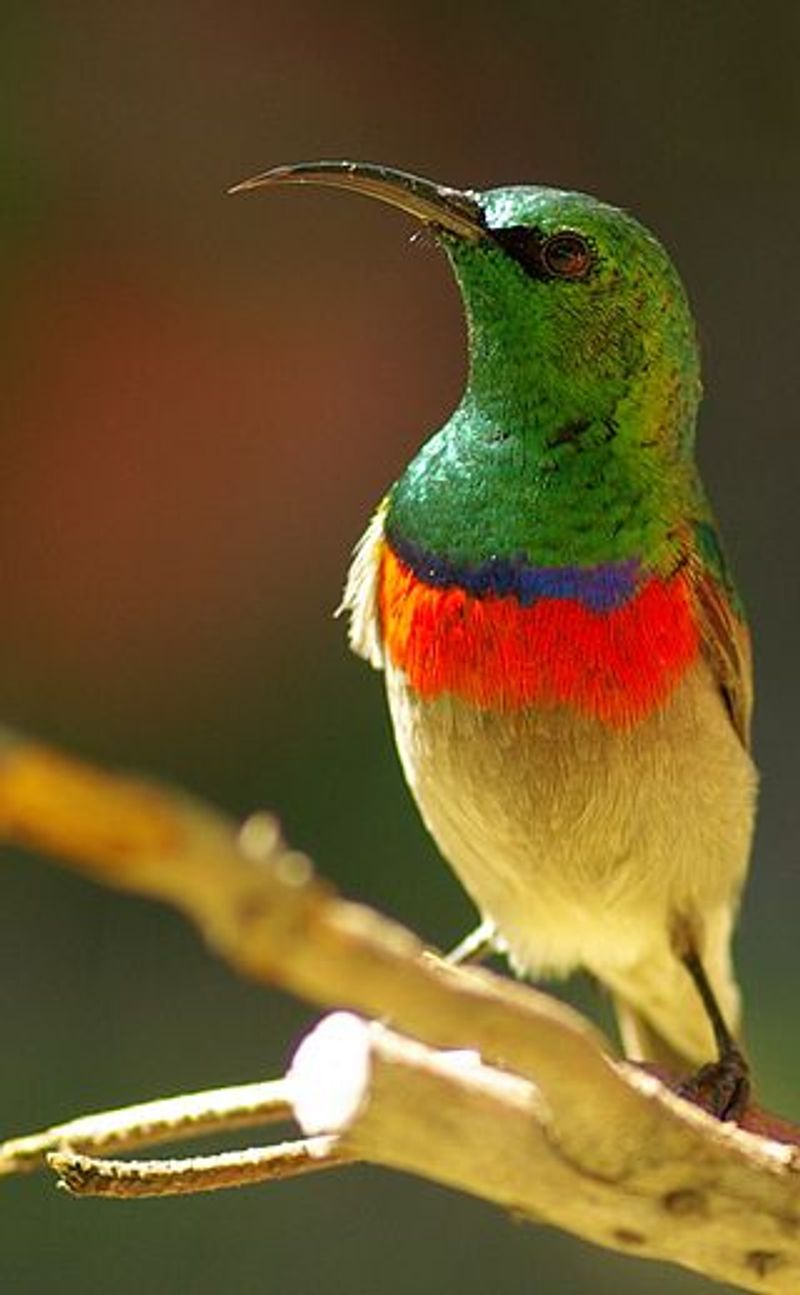
The southern double-collared sunbird, or lesser double-collared sunbird, is a small bird found in southern Africa, and is a member of the passerine family. It has a unique, double-collared pattern on its feathers, making it easily recognizable.
It is mainly resident in its range, meaning that it will usually stay in the same area year-round. However, in the northeastern parts of its range, it will partially migrate, usually moving to more temperate climates during the winter months.
This bird feeds mostly on nectar and small insects and can be found in gardens, forests, and even savanna. It is a relatively common sight in its range and is an important pollinator in its natural habitats.
| Kingdom | Animalia |
| Phylum | Chordata |
| Class | Aves |
| Order | Passeriformes |
| Family | Nectariniidae |
| Genus | Cinnyris |
| Species | C. chalybeus |
29. Goliath Heron
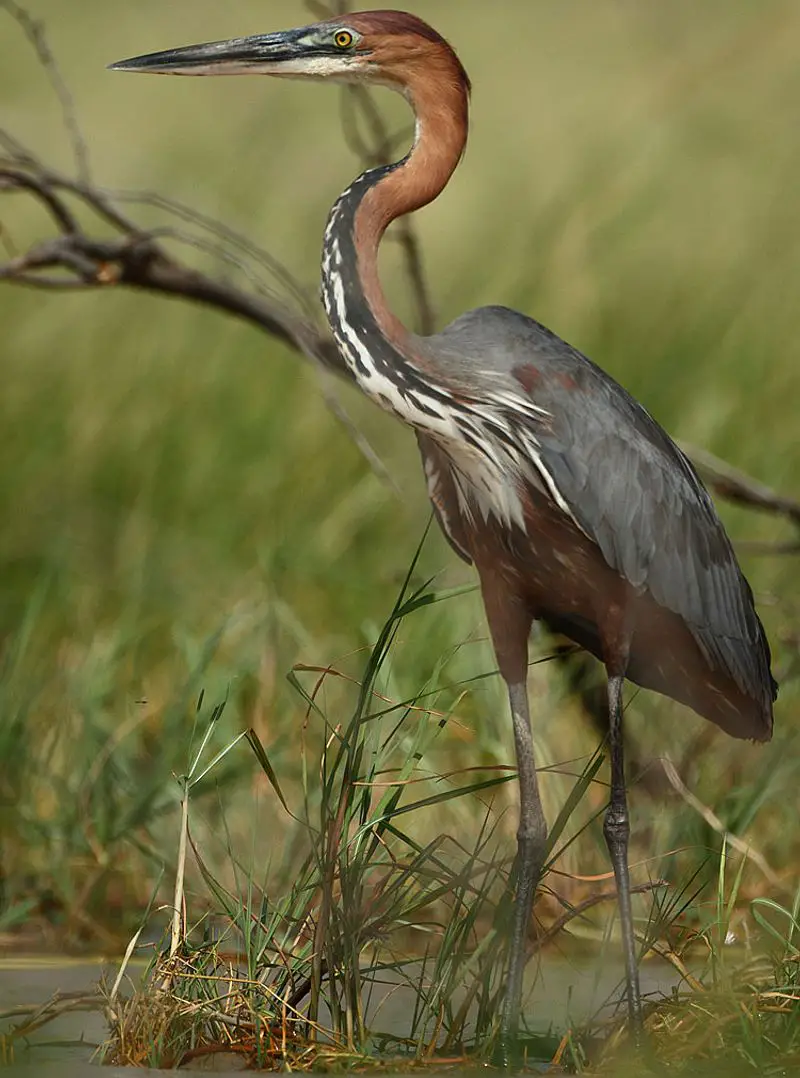
The Goliath heron is a very large wading bird that belongs to the heron family, Ardeidae. It is one of the largest herons in the world and is native to sub-Saharan Africa, with smaller and decreasing numbers also found in Southwest and South Asia.
This majestic bird stands between four to five feet tall, with a wingspan of almost seven feet. It has a very distinct appearance, with a white head, yellowish neck, and greyish-brown body.
Its legs are long and yellow, and its bill is pink and curved. The Goliath heron typically inhabits wetland areas, such as mangroves, marshes, and swamps. It is a solitary hunter, wading in shallow waters and waiting to ambush its prey.
Its diet consists of small fish, frogs, and insects. It is an opportunistic feeder and will take advantage of any food sources that are available. The Goliath heron is an endangered species, primarily due to habitat destruction and pollution.
Other threats include hunting, egg collection, and disturbance from humans. Conservation efforts are being made to protect this species, but more needs to be done in order to ensure its survival.
| Kingdom | Animalia |
| Phylum | Chordata |
| Class | Aves |
| Order | Pelecaniformes |
| Family | Ardeidae |
| Genus | Ardea |
| Species | A. goliath |
30. Spotted Thick-knee
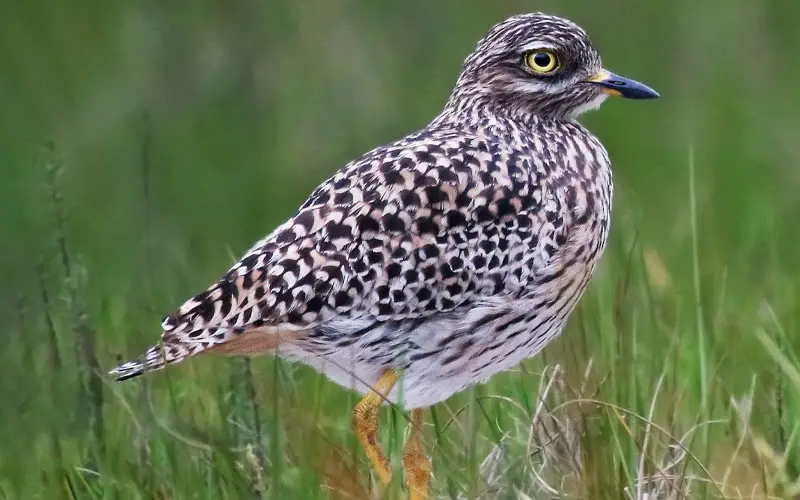
Source: https://ebird.org/
The spotted thick-knee is a bird species found in tropical regions of central and southern Africa. It belongs to the family Burhinidae and is also known as the spotted dikkop or Cape thick-knee. This medium-sized bird is identified by its unique spotted plumage and thick legs.
It has a long bill, which is used to forage for food in shallow water. The spotted thick-knee is a ground-dwelling species and is generally found on beaches, mudflats, and grassland habitats.
Its diet consists of small invertebrates, such as crustaceans, insects, and mollusks. It is a solitary species and typically avoids human contact.
The spotted thick-knee is not considered to be a threatened species, however, its population is in decline due to the destruction of its habitat. Conservation efforts are needed to ensure that this species is not lost forever.
| Kingdom | Animalia |
| Phylum | Chordata |
| Class | Aves |
| Order | Charadriiformes |
| Family | Burhinidae |
| Genus | Burhinus |
| Species | B. capensis |
31. Red-faced Mousebird
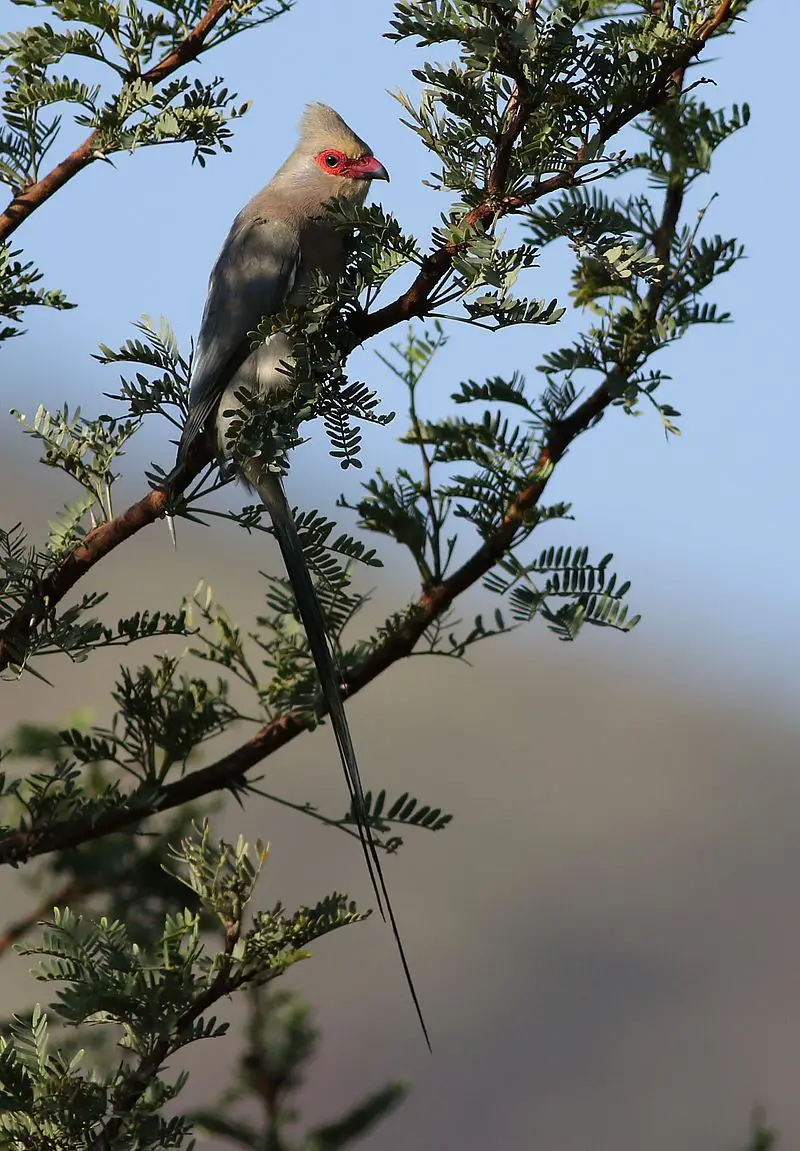
The red-faced mousebird is a species of bird belonging to the family Coliidae. It is commonly found in Southern Africa, ranging from Zaire, Zambia, and Tanzania in the north to the Cape in the south.
This species prefers to inhabit open areas such as savannas, thickets, fynbos scrub, open woodlands, gardens, and orchards. As its name suggests, the red-faced mousebird has a distinctive red face and upper chest. It has a small body with a rounded head and a long tail.
It is an agile bird that feeds mostly on insects, fruit, buds, and flowers. In addition, it has a unique courtship behavior where the male performs a ‘dance’ by hopping and flapping its wings to attract a mate.
The red-faced mousebird is a popular species that is often seen in suburban gardens and parks.
| Kingdom | Animalia |
| Phylum | Chordata |
| Class | Aves |
| Order | Coliiformes |
| Family | Coliidae |
| Genus | Urocolius |
| Species | U. indicus |
32. Laughing Dove
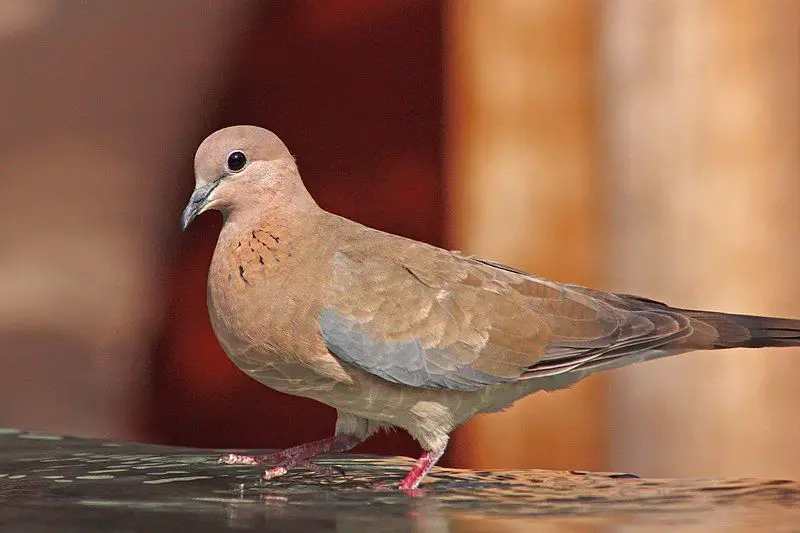
The Laughing Dove is a species of small pigeon that is mainly found in Africa, the Middle East, South Asia, and Western Australia.
This species of bird is a resident breeder, meaning that it breeds in the same areas it lives in rather than migrating away for extended periods of time. The Laughing Dove has also established itself in the wild in Western Australia after being released from Perth Zoo in 1898.
This species of pigeon is found in a wide variety of habitats, ranging from deserts and semi-arid regions to savannas and cultivated areas. They feed on a variety of seeds and small insects, often foraging on the ground.
They are generally social birds that live in small flocks and make a distinctive “cooing” call. They are also known to be very vocal in the early morning and evening.
The Laughing Dove is considered to be a species of Least Concern by the International Union for Conservation of Nature.
| Kingdom | Animalia |
| Phylum | Chordata |
| Class | Aves |
| Order | Columbiformes |
| Family | Columbidae |
| Genus | Spilopelia |
| Species | S. senegalensis |
33. Red-eyed Dove
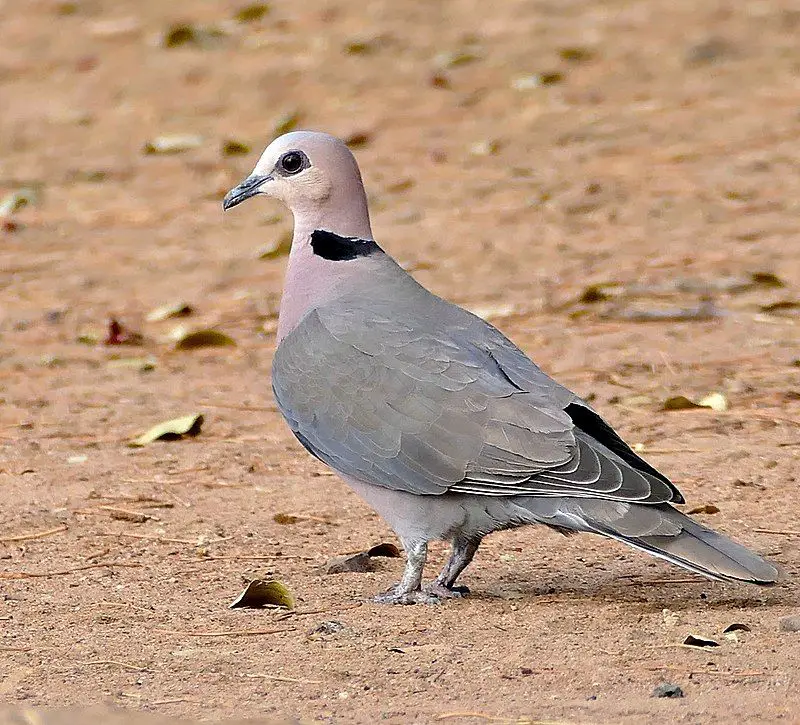
The red-eyed dove is a species of dove that is widespread and common throughout Sub-Saharan Africa. This species of dove is quite unique, as it has bright red eyes. Because of its abundance in the region, it has not been considered to be at risk of extinction.
In 2004, the International Union for Conservation of Nature (IUCN) classified the red-eyed dove as a species of “Least Concern”, meaning that it is not in danger of extinction.
This is due to the fact that this species of dove is quite widespread and common throughout its habitat range. The red-eyed dove is found in a variety of habitats, from grasslands and savannas to woodlands and dense forests.
It is also found in many urban and suburban environments. This species of dove feeds on a variety of seeds, leaves, shoots, and small insects. In addition, it has been observed to eat fruit and flowers.
The red-eyed dove is an important species to its habitat, as it helps to disperse seeds and other plant materials, thus helping to maintain the health of the local ecosystem.
| Kingdom | Animalia |
| Phylum | Chordata |
| Class | Aves |
| Order | Columbiformes |
| Family | Columbidae |
| Genus | Streptopelia |
| Species | S. semitorquata |
34. Red-knobbed Coot
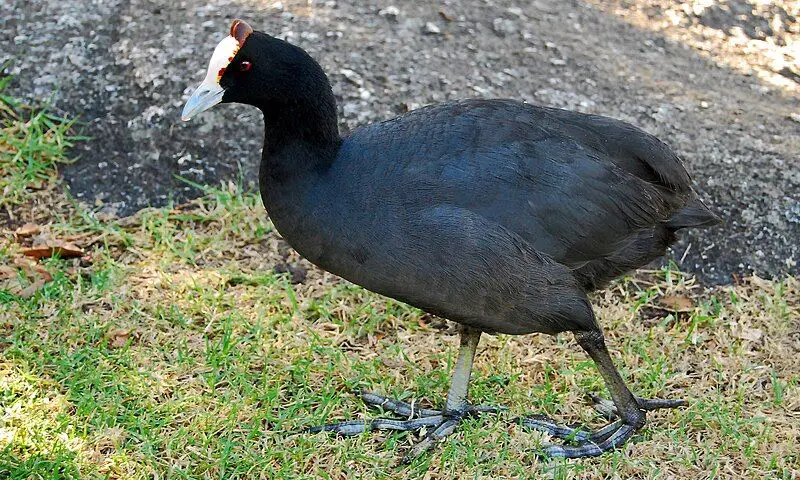
The red-knobbed coot, also known as the crested coot, is a species of bird that belongs to the Rallidae family, which includes rails and crakes. It is native to a wide range of habitats across Africa, as well as in certain parts of Spain.
The red-knobbed coot is a resident breeder, meaning it stays in one area for its entire lifespan. It typically lives near freshwater lakes and ponds, building its nest from dead reeds, which are found near the water’s edge or floating on the water’s surface.
The red-knobbed coot typically lays around seven eggs in a single clutch. The red-knobbed coot can be identified by its distinctive red knob on top of its head and its white and black plumage.
It has a long black bill and red irises, and its wings are black and white with a white rump and tail. The red-knobbed coot is a fairly large bird, measuring up to 45 cm in length. The red-knobbed coot is an omnivore, feeding on aquatic plants, insects, and crustaceans.
It is known to forage in the shallow water, prodding mud with its bill to find food. It is also known to feed on the ground near the water’s edge. The red-knobbed coot is a social bird and is often seen in large flocks.
It is vocal, making a variety of loud and repetitive calls when in flight or on the ground.
It is also known to have a variety of courtship displays, such as head-nodding and wings-flicking. The red-knobbed coot is an important species in its range, providing food and habitat for other species of birds and animals.
It is also an important part of the local ecosystem, helping to maintain the health of its wetland habitats.
| Kingdom | Animalia |
| Phylum | Chordata |
| Class | Aves |
| Order | Gruiformes |
| Family | Rallidae |
| Genus | Fulica |
| Species | F. cristata |
35. Ring-necked Dove
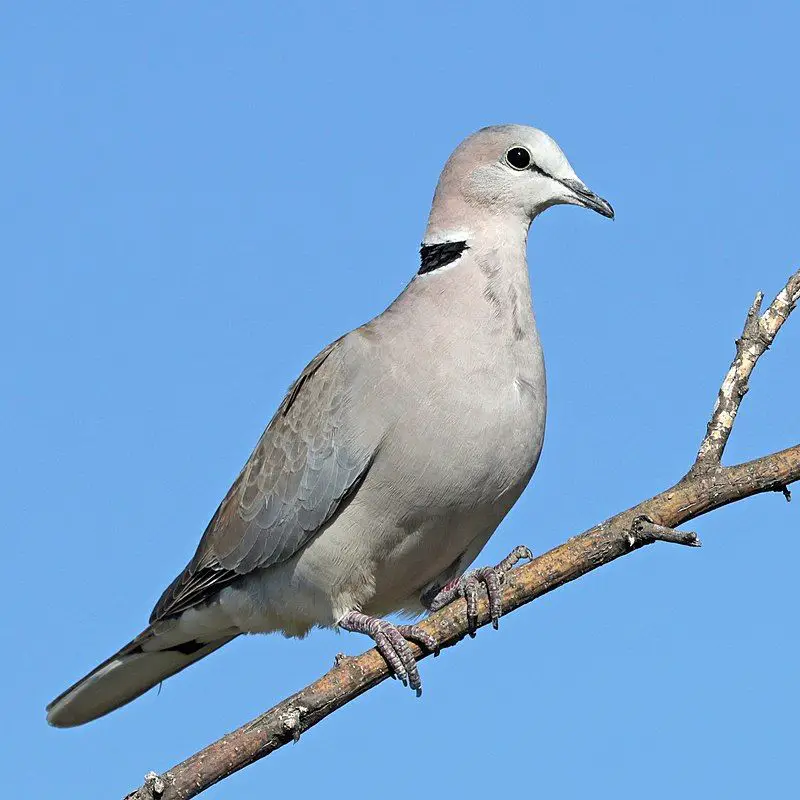
The ring-necked dove is a species of dove that is found in East and southern Africa. It is a common sight in many habitats, including grasslands, woodlands, savannas, and scrublands. It is also known as the Cape turtle dove or half-collared dove.
The ring-necked dove is a mostly sedentary bird, meaning that it does not migrate and tends to stay in the same area throughout the year. It is usually found in open habitats, such as those where there is plenty of food and water sources.
It is an omnivorous species, meaning that it eats both plants and animals. It mainly feeds on seeds, fruits, and insects. The ring-necked dove is a very social species, usually found in small groups of up to 10 individuals.
It is a relatively calm dove species and is not easily disturbed by humans. Its call is a soft, cooing sound and it is known to have a wide range of vocalizations.
| Kingdom | Animalia |
| Phylum | Chordata |
| Class | Aves |
| Order | Columbiformes |
| Family | Columbidae |
| Genus | Streptopelia |
| Species | S. capicola |
36. Cape Rock Thrush
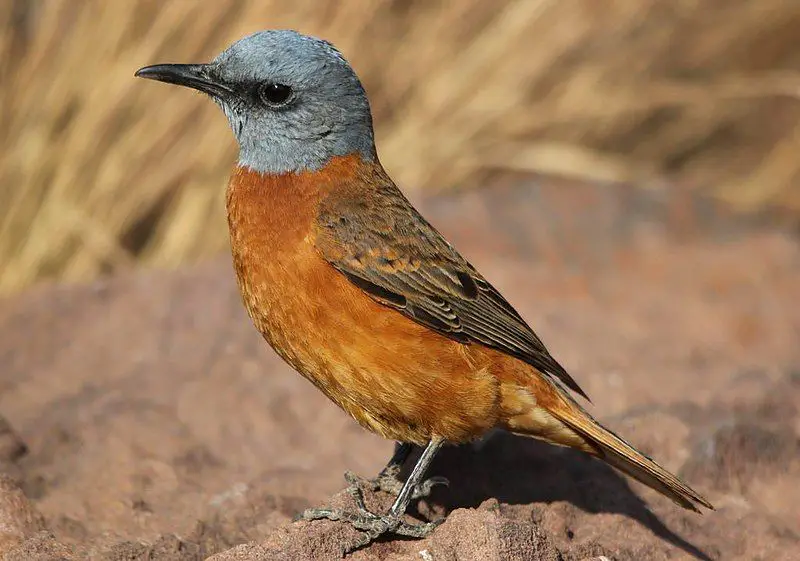
The Cape rock thrush is a species of bird belonging to the Muscicapidae family. It can be found in the south and east of South Africa, as well as in the smaller surrounding countries of Lesotho and Eswatini.
This species of rock thrush is a common resident in these regions and generally does not migrate. However, in certain areas, they may move to higher altitudes in order to better suit their needs during certain seasons.
They are native to the region and have adapted to the local environment. This species of bird prefers rocky habitats, as indicated by its name. They feed on a variety of insects, fruits, and seeds, which they can find among the rocks.
The Cape Rock thrush is an important part of the local ecology, providing food for other species and helping to control insect populations.
| Kingdom | Animalia |
| Phylum | Chordata |
| Class | Aves |
| Order | Passeriformes |
| Family | Muscicapidae |
| Genus | Monticola |
| Species | M. rupestris |
37. Cardinal Woodpecker
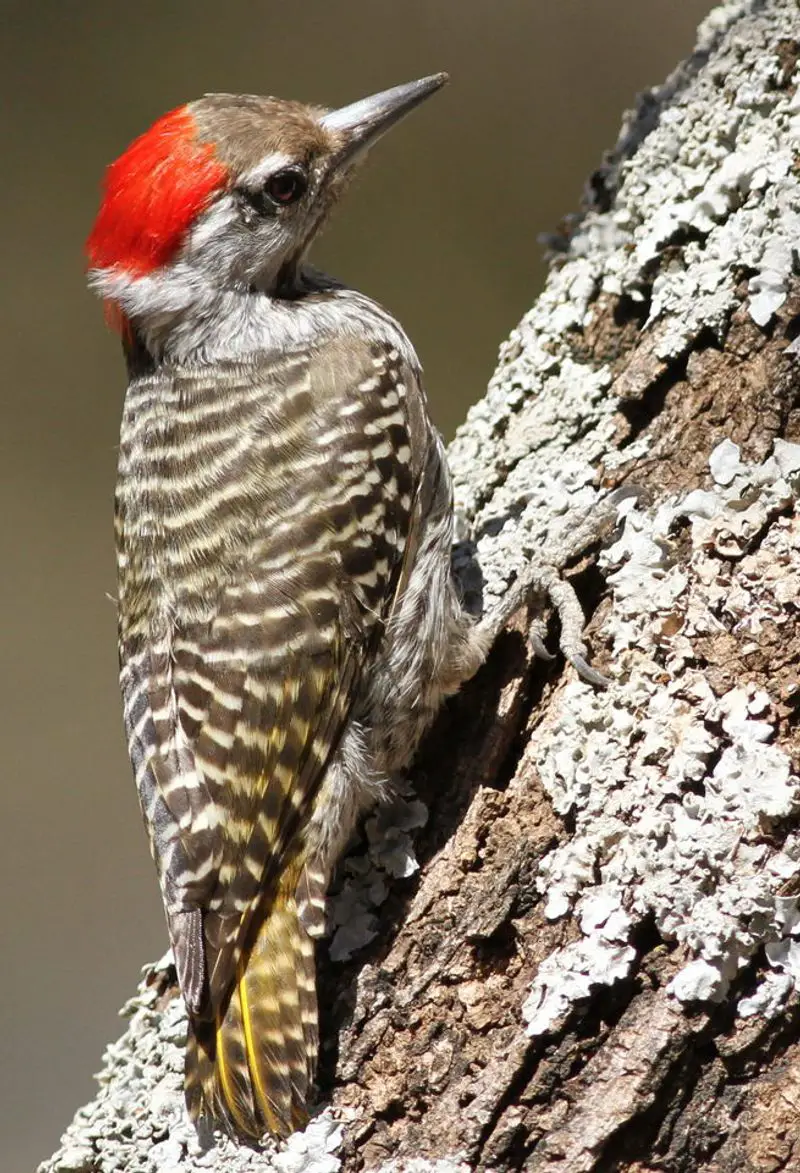
The cardinal woodpecker is a widely distributed bird species found throughout much of sub-Saharan Africa. It is a common resident breeder in these areas and is found in a variety of habitats including dense forests, thickets, and even thorny scrublands.
The cardinal woodpecker is easily identifiable due to its loud, distinctive call notes. Additionally, the sexes of this species can be distinguished from each other due to their distinct head patterns.
The male cardinal woodpecker typically has a redhead, while the female’s head is usually brown or grey. Overall, the cardinal woodpecker is a widespread and abundant species that is found in many different types of habitats across sub-Saharan Africa.
| Kingdom | Animalia |
| Phylum | Chordata |
| Class | Aves |
| Order | Piciformes |
| Family | Picidae |
| Genus | Dendropicos |
| Species | D. fuscescens |
38. African Spoonbill
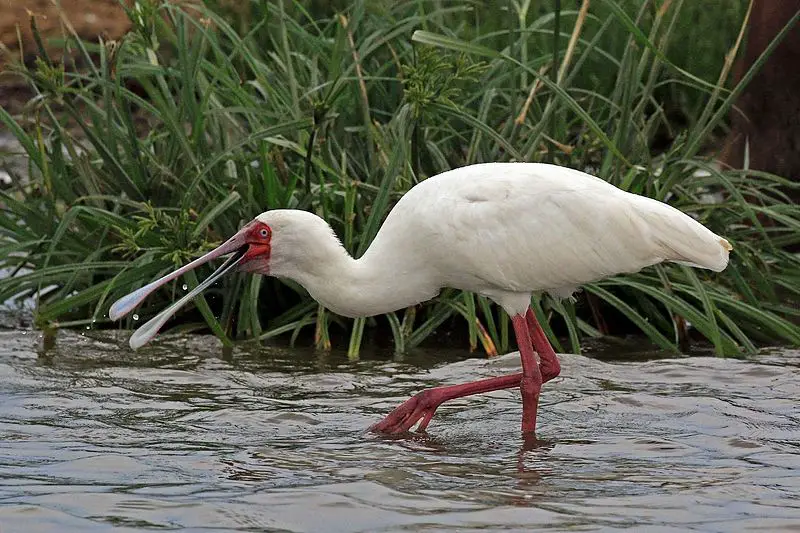
The African spoonbill is a beautiful and distinct species of bird that is found in many parts of Africa and Madagascar. It belongs to the ibis and spoonbill family Threskiornithidae, which is a group of long-legged wading birds.
It has a wide range, spanning countries such as Botswana, Kenya, Mozambique, Namibia, South Africa, and Zimbabwe. The African spoonbill is a large bird, with an average wingspan of up to four feet in length. Its head and neck are white, while its body is black or dark gray.
Its bill is long and spoon-shaped, with a bright yellow tip. Its legs are long and grayish-brown in color.Its diet consists mainly of small fish, insects, and crustaceans, which it forages for in shallow waters.
The African spoonbill can be seen in areas such as lakes, rivers, marshes, and other wetlands.
It is a sociable bird, which can often be seen in large flocks. The African spoonbill is an important species for its ecosystem, as it helps to keep its habitat clean by feeding on small invertebrates.
It is also a key species for its aesthetic value, as it is a beautiful sight to behold in the wild. Despite its wide range, the African spoonbill is threatened by human activities such as habitat destruction and hunting.
| Kingdom | Animalia |
| Phylum | Chordata |
| Class | Aves |
| Order | Pelecaniformes |
| Family | Threskiornithidae |
| Genus | Platalea |
| Species | P. alba |
39. Eurasian Whimbrel
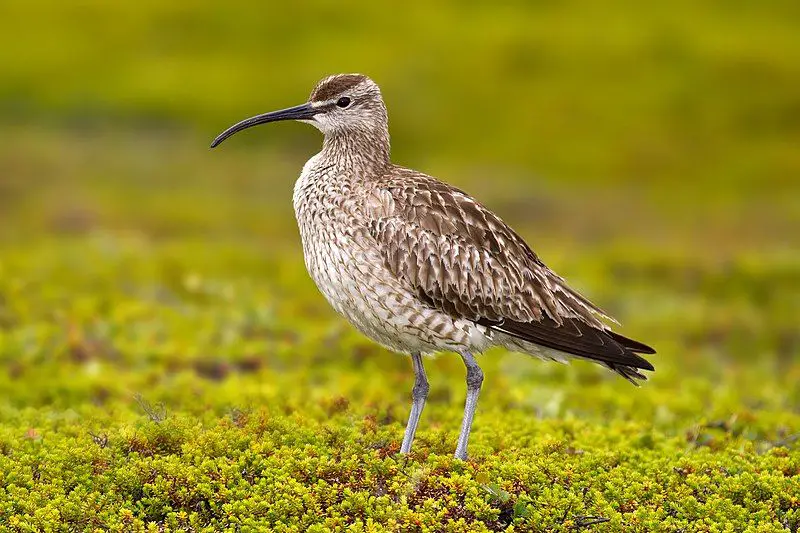
The Eurasian or common whimbrel is a type of wader, belonging to the family Scolopacidae, which includes a variety of shorebirds. It is also known as the white-rumped whimbrel in North America and is one of the most widespread of the curlews.
This species breeds across much of subarctic Asia and Europe, with populations as far south as Scotland. The Eurasian or common whimbrel is found in a variety of habitats, including lowland marshes, coastal mudflats, and wet grasslands.
It feeds mainly on small invertebrates, but also takes some plant material. Its plumage is mainly grey and brown but with a distinctive white rump and chestnut-brown wings.
The Eurasian or common whimbrel is a migratory species, with some populations traveling south in winter to find more suitable conditions. It is generally a solitary bird but may gather in flocks during migration or on its wintering grounds.
The Eurasian or common whimbrel is threatened by human disturbance and habitat loss. It is listed as Least Concern on the IUCN Red List, but its population is declining.
| Kingdom | Animalia |
| Phylum | Chordata |
| Class | Aves |
| Order | Charadriiformes |
| Family | Scolopacidae |
| Genus | Numenius |
| Species | N. phaeopus |
40. Greater Painted-snipe
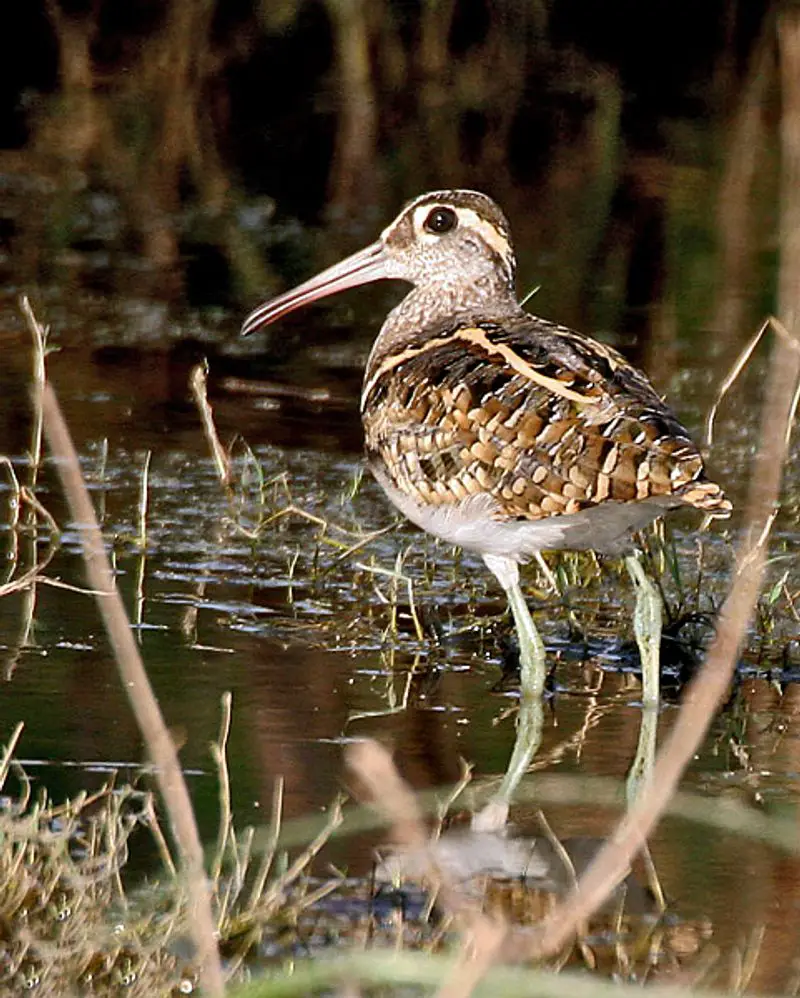
The greater painted-snipe is a species of wader belonging to the family Rostratulidae. This species is found in wetlands and marshes in various regions of Africa, South Asia, and Southeast Asia.
It has a distinctively colored plumage that varies from grey to brown and reddish-orange. The greater painted snipe’s head and neck are patterned with streaks of black, white, and brown.
Its wings are long and narrow, and its legs are short and stout. The greater painted-snipe feeds mainly on insects, crustaceans, and mollusks which it finds in the shallow waters of marshes. It is also known to feed on plant matter, such as seeds and fruit.
This species typically makes its nest in the reeds and grasses of its wetland habitat.
The greater painted-snipe is a shy and reclusive bird but can be quite vocal during the breeding season. The greater painted-snipe is a species of conservation concern, as its wetland habitats are becoming increasingly fragmented and degraded.
As a result, the population of this species is in decline. Conservation efforts, such as habitat protection and restoration, are needed in order to ensure the future of the greater painted-snipe.
| Kingdom | Animalia |
| Phylum | Chordata |
| Class | Aves |
| Order | Charadriiformes |
| Family | Rostratulidae |
| Genus | Rostratula |
| Species | R. benghalensis |
41. Cape Gannet
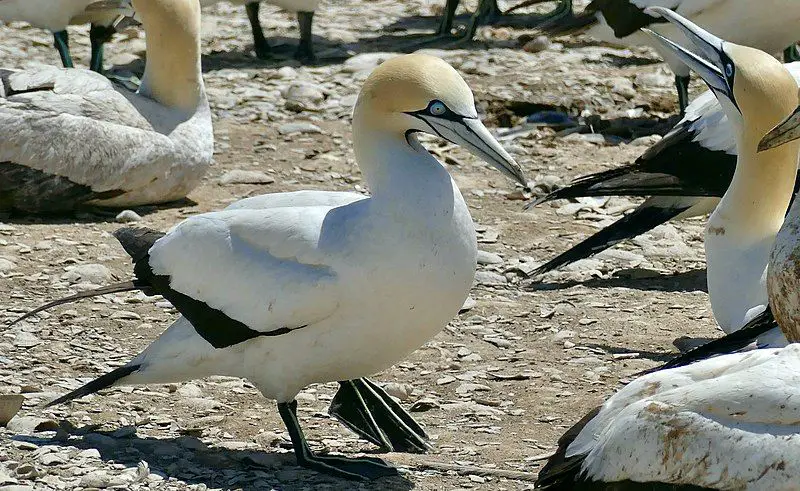
The Cape Gannet is a species of seabird belonging to the Sulidae family. They are easily recognizable due to their large size, black and white plumage, and distinctive yellow crown and hindneck.
The Cape Gannet is a striking bird, measuring up to nearly three feet in length with a wingspan of up to five feet. Its black and white plumage is broken up by a bright yellow crown and nape of the neck, a feature that helps to distinguish it from other species of gannets.
The Cape Gannet is a diving bird, spends much of its time searching for food in the ocean. It has adapted to be an expert hunter, able to dive from heights of up to 30 meters and reach speeds of up to 200km/hr when in flight.
The diet of the Cape Gannet consists mainly of fish, supplemented by squid and other sea creatures. The Cape Gannet is found in the coastal waters of South Africa and Namibia, where it breeds in large colonies on rocky islands.
These colonies are usually located far from the mainland, thus providing the birds with a safe place to raise their young. The Cape Gannet is an important species in the marine ecosystem, as it helps to keep the fish population in check.
The Cape Gannet is a beautiful and majestic species of bird and is an important part of the marine ecosystem.
Its bright yellow crown and hindneck make it an easily identifiable bird, and its ability to dive from great heights and reach incredible speeds makes it an impressive sight to behold.
| Kingdom | Animalia |
| Phylum | Chordata |
| Class | Aves |
| Order | Suliformes |
| Family | Sulidae |
| Genus | Morus |
| Species | M. capensis |
42. Blacksmith Lapwing
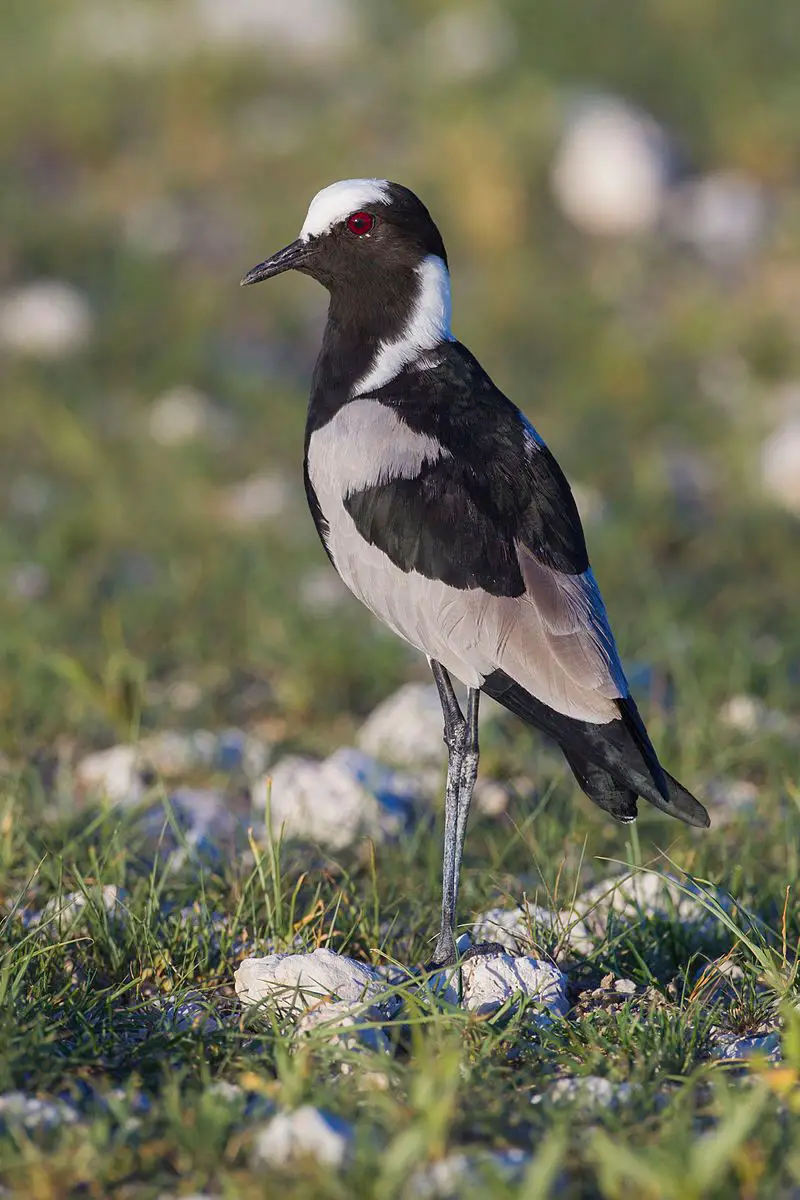
The blacksmith lapwing or blacksmith plover is a species of lapwing, a type of wading bird found in various parts of Africa. The species is found from Kenya through central Tanzania to southern and southwestern Africa.
It is named for its distinct call, which sounds like a blacksmith’s hammer striking an anvil. The call is a loud, repeated metallic noise, often heard early in the morning or in the evening.
This is a useful way for the species to communicate with each other, warning of potential danger or alerting nearby members of its group.The blacksmith lapwing is typically found near sandy or muddy areas, such as marshes, riverbanks, and lakes.
The bird is fairly large, measuring between 30 and 35 centimeters in length. It has a black crown and nape, and its back is spotted with white. Its wings have a white and black pattern, and its tail is black with white edges.
The bird also has a bright yellow eye-ring and red legs and feet. The blacksmith lapwing feeds mainly on insects, worms, and other small invertebrates. It is a ground-dwelling species, so it spends most of its time foraging on the ground.
Its diet is supplemented with seeds, and it also eats small amounts of berries and fruit. The blacksmith lapwing is an important part of African ecosystems. It helps to keep populations of insects from becoming too large, which helps to keep crops and gardens healthy.
The species is also an important part of African culture, with its distinct call often used in music and storytelling.
| Kingdom | Animalia |
| Phylum | Chordata |
| Class | Aves |
| Order | Charadriiformes |
| Family | Charadriidae |
| Genus | Vanellus |
| Species | V. armatus |
43. Grey-winged Francolin
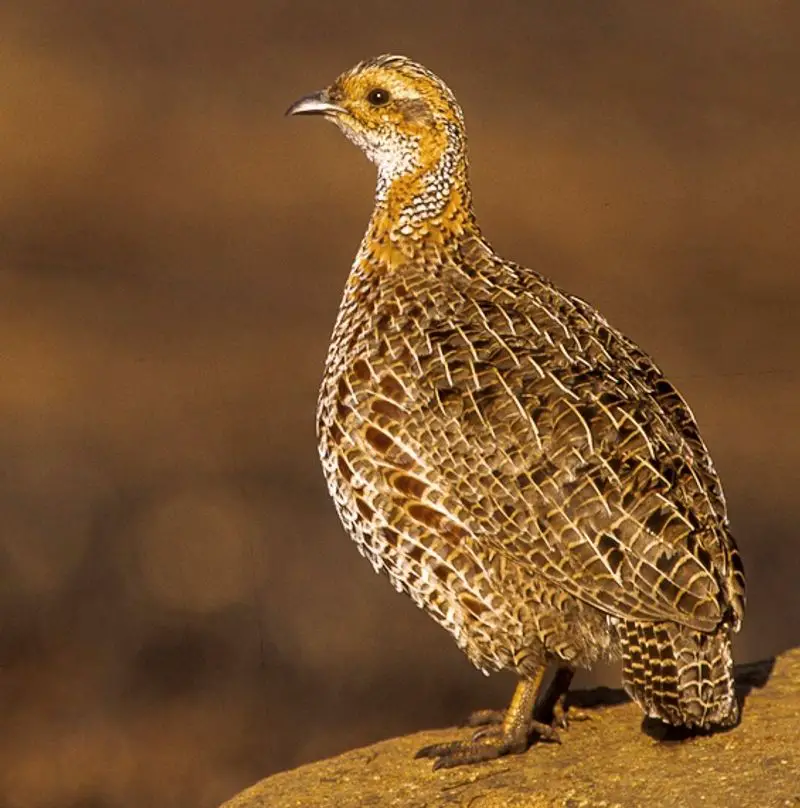
The grey-winged francolin is a species of bird that belongs to the Phasianidae family. This bird is native to two countries, Lesotho and South Africa. This species can be identified by its distinctive grey plumage on its wings.
The body of the bird is mostly a reddish-brown color with a black tail. It has a long, pointed beak and long legs for walking on the ground. The grey-winged francolin typically lives in grasslands and open woodlands where it feeds on insects, seeds, and small reptiles.
It is also known to take advantage of agricultural fields, and may even come to human settlements for food. The species has been classified as Near Threatened by the International Union for Conservation of Nature (IUCN).
This is due to habitat loss from agricultural activities and hunting for food and sport. Conservation efforts are being made to protect this species, including habitat restoration and enforcement of laws that prevent hunting.
| Kingdom | Animalia |
| Phylum | Chordata |
| Class | Aves |
| Order | Galliformes |
| Family | Phasianidae |
| Genus | Scleroptila |
| Species | S. afra |
44. Malachite Sunbird
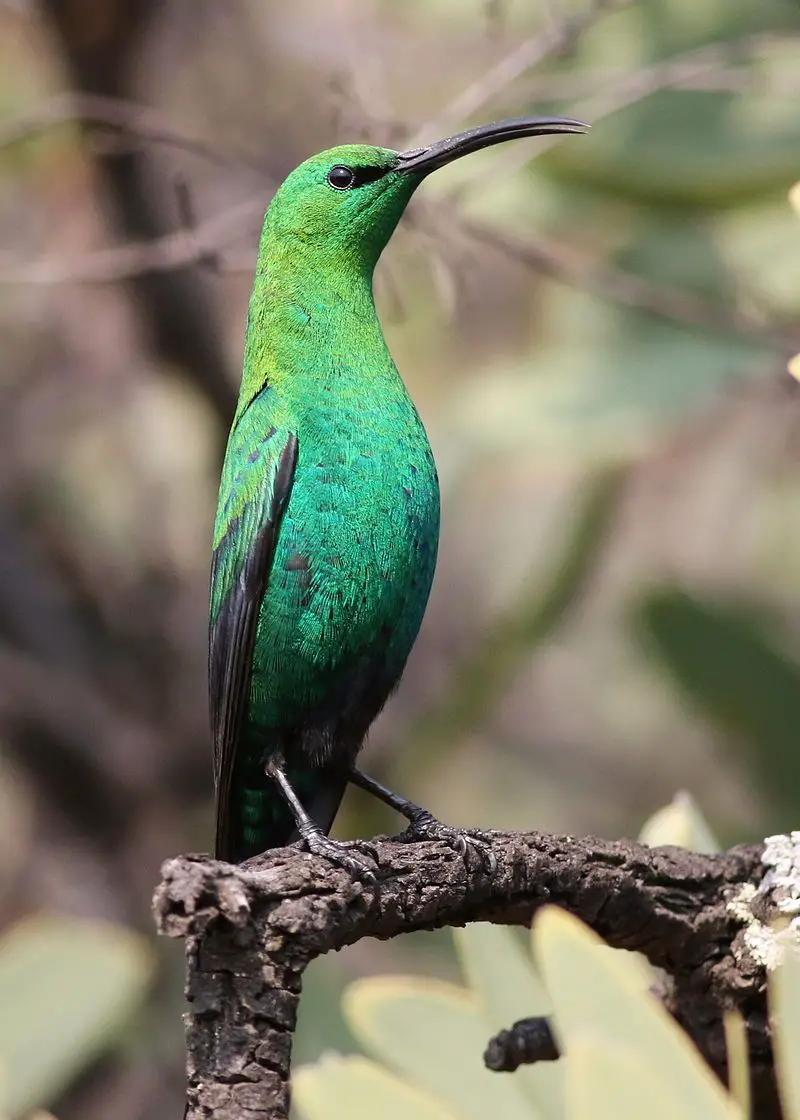
The malachite sunbird is a type of bird that resides in the highlands of Ethiopia all the way down to South Africa. These small birds feed on nectar from flowering plants, and they are particularly drawn to plants with long corolla tubes found in the Fynbos biome.
As a result, they help to pollinate these plants and contribute to the health of the Fynbos ecosystem. Malachite sunbirds are small birds, usually measuring between 4 to 5 inches in length.
They have bright green feathers on their heads and backs, with a reddish-brown chest and patches of bluish-black feathers on their wings.
The male sunbirds have longer tails than the females, and they have a long curved bill that is perfect for gathering nectar from deep within the flower. When the malachite sunbird feeds on nectar, it also collects pollen on its body.
As it travels from flower to flower, it helps to pollinate the plants it visits. This is especially important in the Fynbos biome, which is home to many different types of flowering plants with long, narrow corolla tubes.
The malachite sunbird is able to reach the nectar in these deep tubes, allowing it to pollinate these plants and help to keep the Fynbos ecosystem healthy.
The malachite sunbird is a vital part of the Fynbos ecosystem, and it is important to the health of the plants that live there.
Without the help of the malachite sunbird, many of these plants would not be able to reproduce, making it difficult for them to continue to thrive in their environment.
| Kingdom | Animalia |
| Phylum | Chordata |
| Class | Aves |
| Order | Passeriformes |
| Family | Nectariniidae |
| Genus | Nectarinia |
| Species | N. famosa |
45. Little Stint
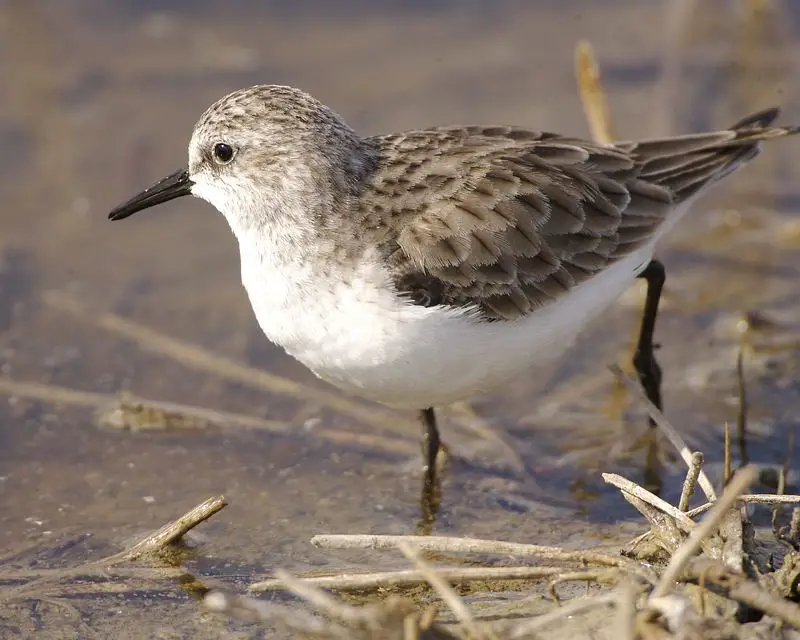
The little stint is a small wader and is found in the arctic regions of Europe and Asia. It is well known for its migratory habits and spends the winters in Africa and south Asia. Occasionally, it has been seen as a vagrant in North America and Australia.
This is a remarkable feat, considering its tiny size. The little stint is a species of small waders and is part of the plover family. It is known for its small size, usually ranging from 11-13 cm in length. It has a dark brown back, grey head and neck, and a white belly.
Its bill is typically black and slender. The small size of the little stint does not deter it from great migrations. During the summer months, it breeds in the Arctic regions of Europe and Asia, before embarking on a long-distance journey when the cold weather arrives.
It travels south, to countries in Africa and South Asia, where it spends the winter. Vagrancy is not uncommon for the little stint, and it has been seen in North American and Australian waters. This is quite extraordinary, considering the small size of the little stint.
It is a testament to the hardiness of this species, and its impressive ability to travel long distances.
| Kingdom | Animalia |
| Phylum | Chordata |
| Class | Aves |
| Order | Charadriiformes |
| Family | Scolopacidae |
| Genus | Calidris |
| Species | C. minuta |
46. Green Wood Hoopoe
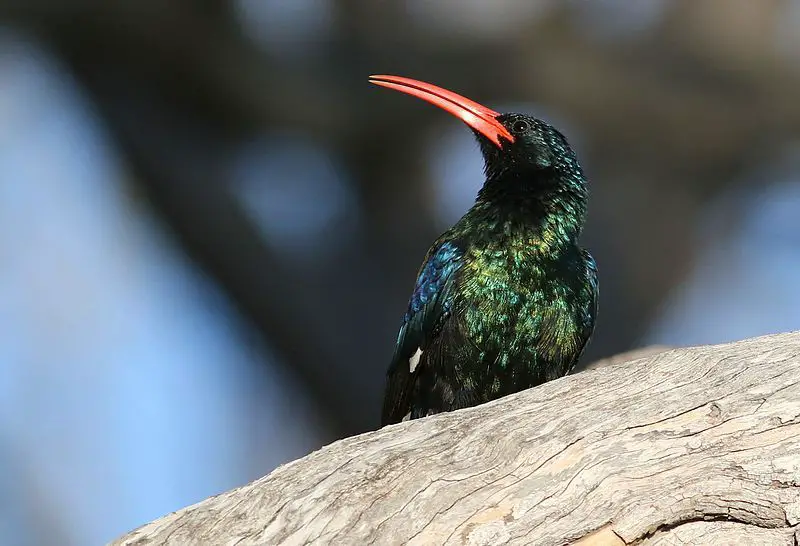
The green wood hoopoe is a large tropical bird native to Africa. It is part of the Phoeniculidae family, which is known as wood hoopoes. It can grow up to 44 centimeters long, making it one of the larger bird species in its family.
It is classified as a near-passerine bird, meaning that it is related to perching birds, but does not actually perch. It was formerly referred to as the red-billed wood hoopoe due to its distinctive red bill, which is also one of its most striking features.
It has a glossy green body, with red and white markings on the wings and tail. Its long, curved bill is used for probing into tree bark and crevices for insects, its main source of food.
The green wood hoopoe is an important species to its ecosystem, as its diet consists of many potential pest species, helping to keep their populations in check.
| Kingdom | Animalia |
| Phylum | Chordata |
| Class | Aves |
| Order | Bucerotiformes |
| Family | Phoeniculidae |
| Genus | Phoeniculus |
| Species | P. purpureus |
Conclusion
The birds of the Western Cape offer an astonishingly diverse and vibrant array of species, from the majestic African Fish Eagle and the iconic Blue Crane to the tiny Cape Sugarbird and Ground Woodpecker.
This remarkable array of life provides a unique and precious window into the natural world and, when coupled with the region’s scenic beauty, makes it one of the most rewarding places to observe and study birds in the world.